Zitierweise | cite as: Amarasiṃha <6./8. Jhdt. n. Chr.>:
Nāmaliṅgānuśāsana (Amarakośa) / übersetzt von Alois Payer <1944 - >. -- 2.
Dvitīyaṃ kāṇḍam. -- 9. siṃhādivargaḥ. -- 11. Vers 30 -
37 (Pfauen und andere
Vögel). -- Fassung vom 2011-01-20. -- URL:
http://www.payer.de/amarakosa2/amara209k.htm
Erstmals hier publiziert: 2011-01-20
Überarbeitungen:
©opyright:
Creative Commons Lizenz (Namensnennung, keine kommerzielle Nutzung, share
alike)
Dieser Text ist Teil der Abteilung
Sanskrit
von Tüpfli's Global Village Library
|

Meinem Lehrer und Freund
Prof. Dr. Heinrich von
Stietencron
ist die gesamte
Amarakośa-Übersetzung
in Dankbarkeit gewidmet. |
|
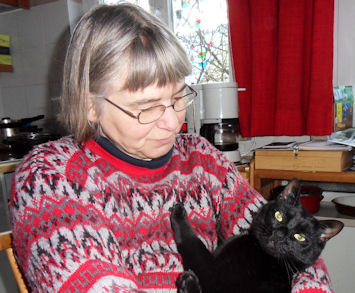
Meiner lieben Frau
Margarete Payer
die all meine Interessen teilt und fördert
ist das Tierkapitel in
Dankbarkeit besonders gewidmet |
Falls Sie die diakritischen Zeichen nicht dargestellt bekommen, installieren Sie
eine Schrift mit Diakritika wie z.B. Tahoma.
Die Devanāgarī-Zeichen sind in Unicode kodiert. Sie benötigen also eine
Unicode-Devanāgarī-Schrift.
|
"Those who have never considered the subject are
little aware how much the appearance and habit of a plant become
altered by the influence of its position. It requires much
observation to speak authoritatively on the distinction in point of
stature between many trees and shrubs. Shrubs in the low country,
small and stunted in growth, become handsome and goodly trees on
higher lands, and to an inexperienced eye they appear to be
different plants. The Jatropha curcas grows to a tree some 15
or 20 feet on the Neilgherries, while the Datura alba is
three or four times the size in>n the hills that it is on the
plains. It is therefore with much diffidence that I have
occasionally presumed to insert the height of a tree or shrub. The
same remark may be applied to flowers and the flowering seasons,
especially the latter. I have seen the Lagerstroemia Reginae,
whose proper time of flowering is March and April, previous to the
commencement of the rains, in blossom more or less all the year in
gardens in Travancore. I have endeavoured to give the real or
natural flowering seasons, in contradistinction to the chance ones,
but, I am afraid, with little success; and it should be recollected
that to aim at precision in such a part of the description of plants
is almost hopeless, without that prolonged study of their local
habits for which a lifetime would scarcely suffice."
[Quelle: Drury, Heber <1819 - 1872>: The useful plants of
India : with notices of their chief value in commerce, medicine, and
the arts. -- 2d ed. with additions and corrections. London : Allen,
1873. -- xvi, 512 p. ; 22 cm. -- S. VIII f.] |
2. dvitīyaṃ kāṇḍam - Zweiter Teil
2.9. siṃhādivargaḥ - Abschnitt über Löwen und andere Tiere
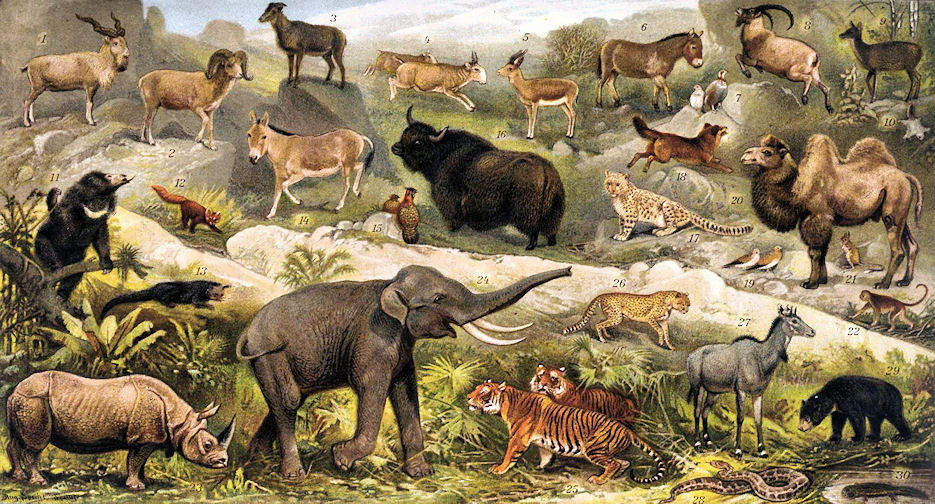
Abb.: Asiatische Tierwelt
[Bildquelle: Brockhaus' Kleines Konversationslexikon, 1906]
Referenzwerke:
Dave, K. N. <1884 - 1983>: Birds in
Sanskrit literature. -- Delhi : Motilal Banarsidass, 1985. -- XXIV, 481 S. :
Ill. -- ISBN 0-89581-676-8. [Referenz für Sanskritbezeichnungen von Vögeln]
Handbook of the birds of India and
Pakistan : together with those of Bangladesh,
Nepal, Bhutan and Sri Lanka ; [in 10 vol.] / Sálim Ali and S. Dillon Ripley.
-- Delhi : Oxford Univ. Pr., 1968 - 1974 [Referenzwerk für Vögel Indiens]
Kazmierczak, Krys
[Text] ; Berlo, Per van [Ill.]: A field guide to the birds of the
Indian subcontinent. -- New Haven : Yale University Press, ©2000. -- 352 S.
: Ill. -- . ISBN 0300079214. [Neue, durchgehend farbig illustrierte
Übersicht über 1330 Vogelarten Indiens]
Rasmussen, Pamela C. ; Anderton, John C.: Birds of
South Asia : the Ripley Guide. -- Washington, D. C. : Smithsonian, 2005. --
2 Bde. -- ISBN 84-87334-67-9. [DAS Standardwerk]
Übersicht
- 2.9.76. Pavo cristatus Linnaeus 1758 - Indian Peafowl - Blauer
Pfau
- 2.9.76.1. Pfau als vāhana und Götterattribut
- 2.9.77. Schrei des Pfauen - Peacock's cry
- 2.9.78. Augen des Pfauenschweifs - Eye of peacock's tail
- 2.9.79. Krönchen des Pfauen - Peacock's crest
- 2.9.80. Schweif des Pfauen - Peacock's tail
- 2.9.81. Bezeichnungen für "Vogel" - "Bird"
- 2.9.82. Chalcophaps indica Linnaeus 1758 - Emerald Dove -
Grünflügeltaube & Treron apicauda Blyth, 1846 - Pin-tailed Green Pigeon &
Treron sphenurus Vigors, 1832 - Wedge-tailed Green
Pigeon - Keilschwanz-Grüntaube
- 2.9.83. Anhinga melanogaster Pennant, 1769 -
Oriental Darter - Altwelt-Schlangenhalsvogel
- 2.9.84. Fulica atra Linnaeus, 1758 - Eurasian Coot -
Blässhuhn & Anas platyrhynchos Linnaeus, 1758 -
Mallard - Stockente & Mergus merganser Linnaeus, 1758 - Common
Merganser - Gänsesäger
- 2.9.85. Phalacrocoracidae - Comorants - Kormorane
- 2.9.86. Francolinus francolinus Linnaeus, 1766
- Black Francolin - Halsbandfrankolin
- 2.9.87. Centropus sinensis Stephens, 1815 - Greater Coucal
& Centropus [sinensis] parroti - 'Southern' Coucal - Chinesischer Spornkuckuck
- 2.9.88. Turnix sp. - Buttonquails - Laufhühnchen & Perdicula
sp. - Bush-quails - Frankolinwachteln
- 2.9.89. Polyplectron bicalcaratum - Grey Peacock-pheasant -
Grauer Pfaufasan
- 2.9.90. Alectoris chukar Gray, 1830 - Chukar Partrigde -
Chukarhuhn
- 2.9.91. Vanellus indicus Boddaert, 1783 - Red-wattled
Lapwing - Rotlappen-Kiebitz
- 2.9.92. Vanellus indicus Boddaert, 1783 - Red-wattled Lapwing -
Rotlappen-Kiebitz & Vanellus malabaricus Boddaert, 1783 - Yellow-wattled Lapwing
- Gelblappen-Kiebitz & Vanellus duvaucelii Lesson, 1826 - River Lapwing -
Flusskiebitz
- 2.9.93. Coturnix coturnix Linnaeus, 1758 - Common Quail - Wachtel
- 2.9.94. Coturnix coromandelica Gmelin, 1789 - Rain Quail - Regenwachtel &
Coturnix chinensis Linnaeus, 1766 - Blue-breasted Quail -
Zwergwachtel
- 2.9.95. Vogelflügel / Schwinge - Wing
- 2.9.96. Ansatzstelle des Flügels (Schulter) - Wing's root
- 2.9.97. Vogelschnabel - Beak
- 2.9.98. Flugtechniken - Acts of flying
- 2.9.99. Vogeleier - Bird's eggs
- 2.9.100. Vogelnest - Nest
2.9.76. Pavo cristatus Linnaeus 1758 - Indian Peafowl - Blauer
Pfau
Männchen: 110 cm (mit Schwanz: 2 - 2.5 m); Weibchen: 86 cm
30. mayūro barhiṇo barhī nīlakaṇṭho bhujaṃgabhuk
śikhāvalaḥ śikhī kekī meghanādānulāsy api
मयूरो बर्हिणो बर्ही नीलकण्ठो
भुजंगभुक् ।
शिखावलः शिखी केकी मेघनादानुलास्य् अपि ॥३०॥
[Bezeichnungen für
Pavo cristatus Linnaeus 1758 - Indian Peafowl - Blauer
Pfau:]
-
मयूर - mayūra m.: Pfau
- बर्हिण
- barhiṇa m.: der einen Besonderen Schweif hat
- बर्हिन् - barhin m.: der
einen Besonderen Schweif hat
- नीलकण्ठ
- nīlakaṇṭha m.: Blauhals
- भुजंगभुज् - bhujaṃgabhuj
m.: Schlangen-Fresser
- शिखावल
- śikhāvala m.: der eine Kronenreihe hat
- शिखिन् - śikhin m.: der eine
besondere Krone hat
- केकिन् - kekin m.: der
als besonderes Merkmal den Pfauenschrei hat
- मेघनादानुलासिन्
- meghanādānulāsin m.: der zum Donner tanzt
|
Colebrooke (1807): "A peacock."
In Indien kommt vor:
- Pavo cristatus Linnaeus, 1758 - Indian Peafowl - Blauer Pfau
(Ob Pavo muticus Linnaeus, 1766 - Green Peafowl - Grüner Pfau je in
Nordostindien vorkam, ist umstritten)
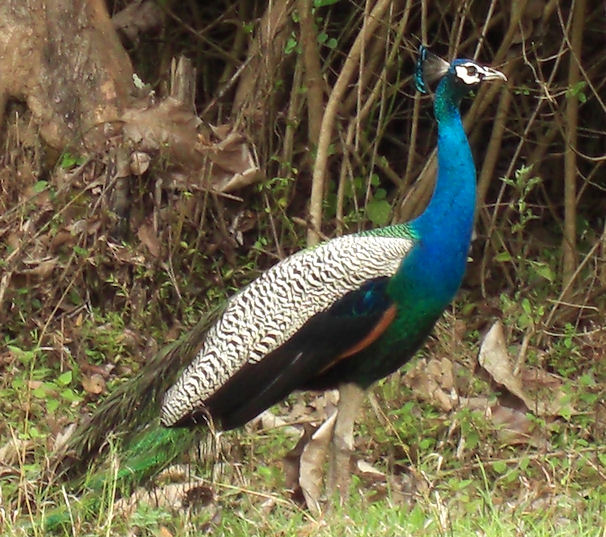
Abb.: नीलकण्ठः । Pavo cristatus Linnaeus, 1758 - Indian Peafowl - Blauer Pfau,
Männchen, Bandipur National Park - ಬಂಡಿಪುರ ರಾಷ್ಟ್ರೀಯ ಉದ್ಯಾನವನ, Karnataka
[Bildquelle:
Swaminathan. --
http://www.flickr.com/photos/araswami/2356822165/. -- Zugriff am 2010-12-24.
-- Creative Commons
Lizenz (Namensnennung)]

Abb.: मयूरी । Pavo cristatus Linnaeus, 1758 - Indian Peafowl
- Blauer Pfau, Weibchen mit Jungen, Hodal - होडाल, Haryana
[Bildquelle: J. M. Garg / Wikimedia. -- GNU FDLicense]
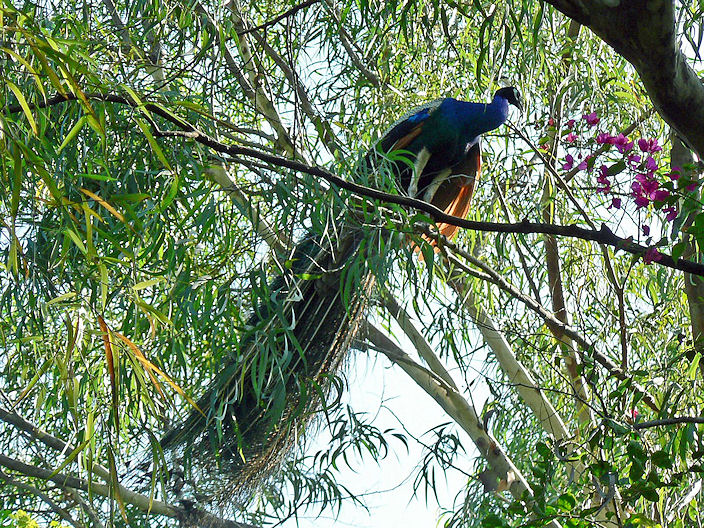
Abb.: बर्हिणः । Pavo cristatus Linnaeus, 1758 - Indian Peafowl - Blauer Pfau,
Männchen, Auroville, ஆரோவில்,
Tamil Nadu
[Bildquelle:
Pandiyan V. --
http://www.flickr.com/photos/pandiyan/130250130/. -- Zugriff am 2010-12-24.
-- Creative
Commons Lizenz (Namensnennung, keine kommerzielle Nutzung)]
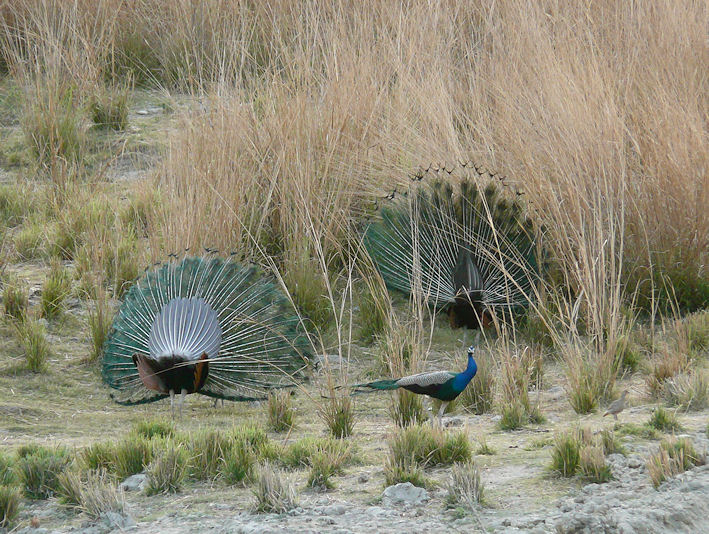
Abb.: बर्हिनौ मयूरी च । Zwei Pfauenmännchen werben um Weibchen, Udaipur -
उदयपुर, Rajasthan
[Bildquelle: Girl in the Rain. --
http://www.flickr.com/photos/graceandpoise/3431181474/. -- Zugriff am
2010-12-24. --
Creative
Commons Lizenz (Namensnennung, keine kommerzielle Nutzung, keine
Bearbeitung)]
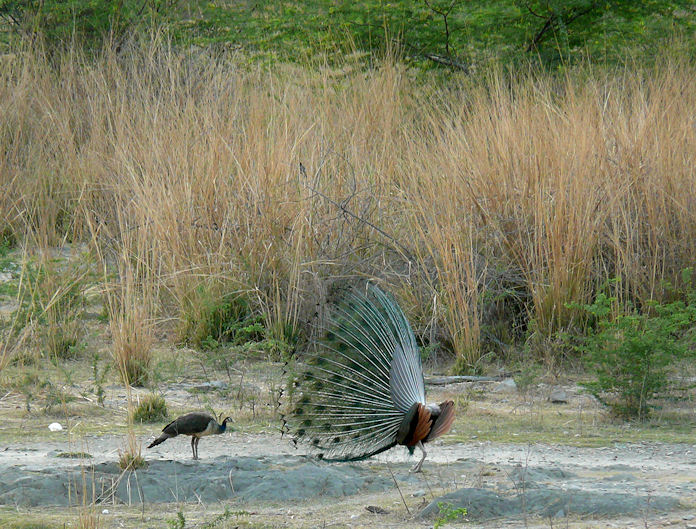
Abb.: बर्ही मयूरी च । Pfauenmännchen wirbt um Weibchen, Udaipur -
उदयपुर, Rajasthan
[Bildquelle: Girl in the Rain. --
http://www.flickr.com/photos/graceandpoise/3431179204/in/photostream/. --
Zugriff am 2010-12-24. --
Creative
Commons Lizenz (Namensnennung, keine kommerzielle Nutzung, keine
Bearbeitung)]
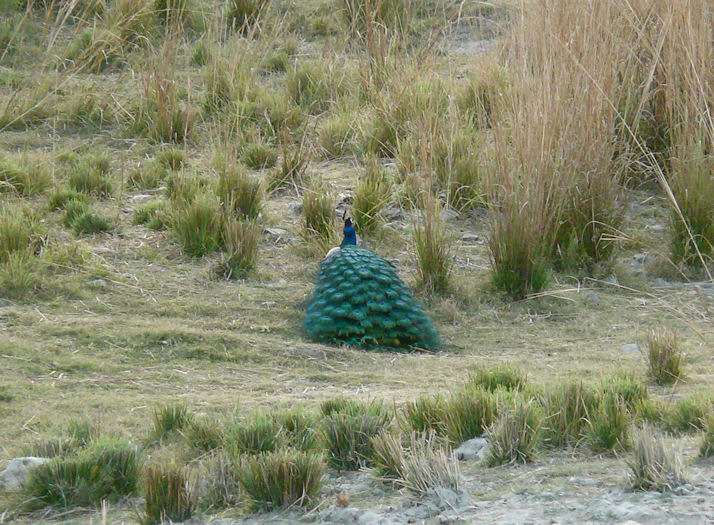
Abb.: बर्हिणः । Der Verlierer gibt auf, Udaipur -
उदयपुर, Rajasthan
[Bildquelle: Girl in the Rain. --
http://www.flickr.com/photos/graceandpoise/3430373277/in/photostream/. --
Zugriff am 2010-12-24. --
Creative
Commons Lizenz (Namensnennung, keine kommerzielle Nutzung, keine
Bearbeitung)]
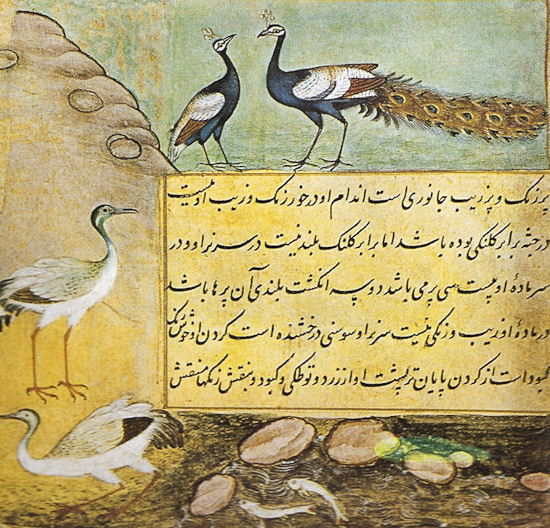
Abb.: मयूरौ । Pfauen, Babur Nama-Manuskript - بابر نامہ,
vor 1530
[Bildquelle: Shyamal / Wikimedia. -- Public domain]
|
"Habitat. Throughout India proper, extending into
Ceylon and Assam. This lovely bird is so well known that any account
of its habits would be superfluous. They generally roost at night on high trees,
seldom, if ever, on the ground, except perhaps when disturbed at night and
are forced to fly down. They pair in the early part of the hot weather,
when the peacock has then his full train of upper tail coverts to display to his
wives. They lay in July and August. Eggs, pure white, or a rich cafe au lait or
reddish buff, with strong glossy shells pitted all over with minute pores. Size 2.55 to 3
x 1.92
to 2.2 inches."
[Quelle: Murray, James A.:
The avifauna of British India and its dependencies. -- London : Trübner,
1888-1890. -- 2 Bde. -- Bd. 2, S. 529.] |
|
"The Pea-fowl is too well known to require a
more ample description. It inhabits the whole of India
Proper, being replaced in Assam and the countries to the East by
another species. It frequents forests, and jungly places, more
especially delighting in hilly and mountainous districts ; and, in
the more open and level country, wooded ravines and river banks
are the never failing resort. It comes forth to the open
glades and fields to feed in the morning and evening, retiring to
the jungles for shelter during the heat of the day, and
roosting at night on high trees. It ascends the Neilgherry and
other mountain regions in Southern India to 6,000 feet or so of
elevation, but it does not ascend the Himalayas, at all events in
Sikim, beyond 2,000 feet. In many parts of the country it is
almost domesticated, entering villages and roosting on the huts,
and it is venerated by the natives in many districts. Many Hindoo
temples have large flocks of them ; indeed, shooting it is
forbidden in some Hindoo States. The Pea-fowl breeds, according
to the locality from April till October, generally in
Southern India towards the close of the rains, laying from 4 to 8 or 9
eggs in some sequestered spot. The Peacock during the courting season
raises his tail vertically, and with it of course the
lengthened train, spreading it out and strutting about to captivate the hen
birds ; and he has the power of clattering the feathers in a
most curious manner. It is a beautiful sight to come suddenly on
twenty or thirty Peafowl, the males displaying their gorgeous
trains, and strutting about in all the pomp of pride before the
gratified females. The train of course increases in length for many
years at each successive moult, but it appears to be shed very
irregularly.
Though it cannot be said to be a favorite
game with Sportsmen in India, yet few can resist a shot at a fine
Peacock whirring past when hunting for small game; yet Pea-chicks
are well worth a morning's shikar for the table, and a plump
young Peahen if kept for two or three days, is really
excellent. An old Peacock is only fit to make soup of.
A bird merely
winged will often escape by the fleetness of its running. They
generally roost on particular trees, and by going early or late to this
place, they can readily be shot. Pea-fowl are easily caught in snares,
common hair-nooses, and are generally brought in alive, for sale
in numbers, in those districts where they abound. In confinement
they will destroy snakes and other reptiles, and in their wild
state feed much on various insects and grubs, also on flower
buds and young shoots, as well as on grain.
The Burmese Pea-fowl, Pavo muticus,
Linnaeus, (P. assamicus, McLelland,) notwithstanding the Linnaean name,
has spurs ; its crest is quite different in structure from that of cristatus, being composed of about ten or more slender barbed feathers.
Though not so showy as the common Peacock, it is, perhaps, a
still more beautiful bird, having more green and gold and less blue in
its plumage. It is found in all the countries to the Eastwards,
from Assam southwards through Burmah to Malacca, and many of the
Islands. Hybrids between the two species are not rare in Aviaries."
[Quelle: Jerdon,
T. C. (Thomas Claverhill) <1811-1872>: The birds of India. --
Calcutta, 1862. -- Vol 2,2. -- S. 507f.] |
2.9.76.1. Pfau als vāhana und Götterattribut
Der Pfau ist das vāhana von Murugan / Subrahmaṇya -
முருகன்,
മുരുകന് / :सुब्रह्मण्य,
ಸುಬ್ರಹ್ಮಣ್ಯ,
సుబ్రహ్మణ్యేశ్వర స్వామి
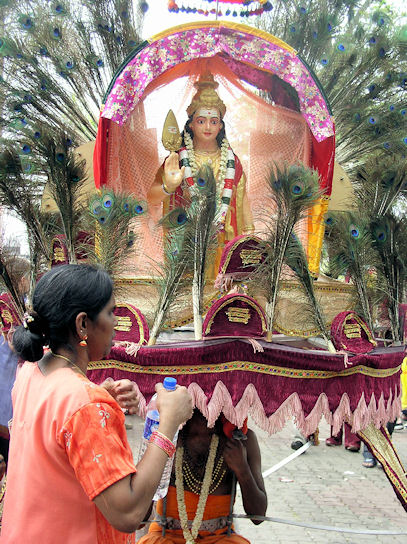
Abb.: Murugan-Prozession, Thaipusam-Fest -
தைப்பூசம், Batu Caves, Kuala Lumpur, Malaysia
[Bildquelle: tajai. --
http://www.flickr.com/photos/cayce/108707865/. -- Zugriff am 2010-12-24. --
Creative Commons
Lizenz (Namensnennung)]
Der Pfau wird manchmal auch verbunden mit Sarasvatī (statt
Gans/Schwan):
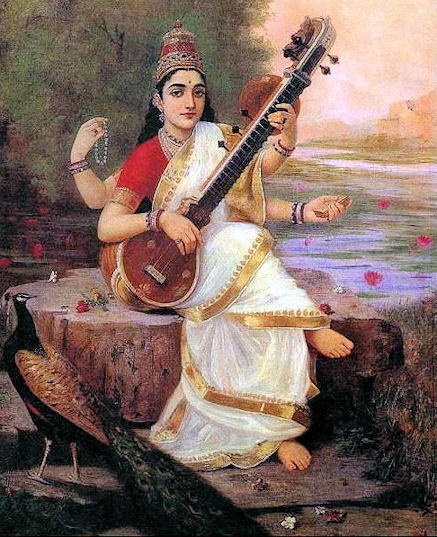
Abb.: Sarasvatī mit Pfau
[Bildquelle: Raja Ravi Varma (രാജാ രവി വര്മ)
<1848 - 1906>]
Kṛṣṇa trägt oft im Haar eine Pfauenfeder:
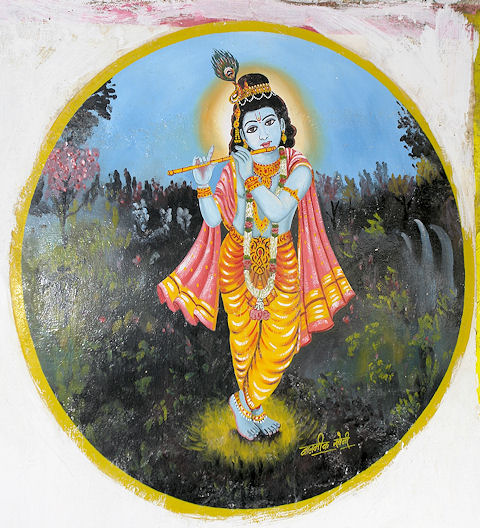
Abb.: Kṛṣṇa mit Pfauenfeder, Wandmalerei an einem Dorftempel, Umaria (उमारिय)
District, Madhya Pradesh
[Bildquelle: Yann / Wikimedia. -- GNU FDLicense]
2.9.77. Schrei des Pfauen - Peacock's cry
|
31. a./b. kekā vāṇī mayūrasya
samau candraka-mecakau केका वाणी मयूरस्य समौ चन्द्रक-मेचकौ ।३१ क।
Der Schrei des Pfauen heißt केका - kekā f.: Kekā |
Colebrooke (1807): "His cry."

केका । Klicken! Schrei des Pfauen
[Quelle der .ogg-Datei: Ke4roh / Wikipedia. -- Public domain]
2.9.78. Augen des Pfauenschweifs - Eye of peacock's tail
|
31. a./b.
kekā vāṇī mayūrasya
samau candraka-mecakau केका
वाणी मयूरस्य समौ चन्द्रक-मेचकौ ।३१ क।
[Bezeichnungen für die Augen des Pfauenschweifs:]
- चन्द्रक
- candraka m.: Möndchen
- मेचक - mecaka m.:
Dunkelblauer
|
Colebrooke (1807): "The eye of his tail."
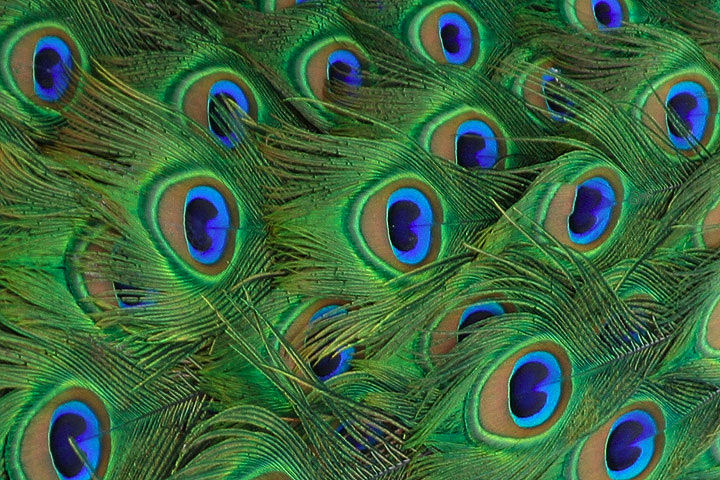
Abb.: चन्द्रकः । मेचकः । Augen des Schweifs von Pavo cristatus Linnaeus 1758 - Indian
Peafowl - Blauer Pfau, Männchen
[Bildquelle: Aaron Logan / Wikipedia. --
Creative Commons Lizenz (Namensnennung)]
2.9.79. Krönchen des Pfauen - Peacock's crest
|
31. c./d. śikhā cūḍā
śikhaṇḍas tu picchabarhe napuṃsake
शिखा चूडा शिखण्डस् तु पिच्छबर्हे नपुंसके
॥३१ ख॥
[Bezeichnungen für das Krönchen des Pfauen:]
-
शिखा - śikhā f.:
Haarbüschel, Haarsträhne, Gipfel, Spitze, Pfauenkrönchen
- चूडा - cūḍā f.:
Scheitelhaarbüschel, Spitze
|
Colebrooke (1807): "His crest."
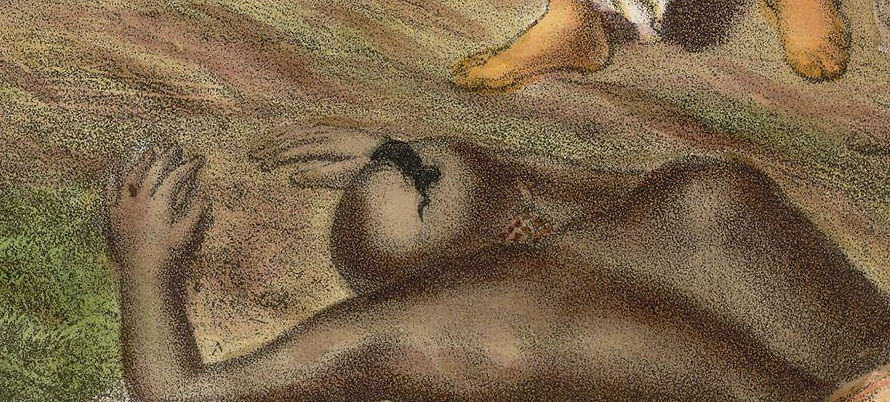
Abb.: शिखा । चूडा ।
[Bildquelle: Sri Chaitanya Mahaprabhu performing 'kirtan'in the
streets of Nabadwip, Bengal; Ausschnitt. Wikimedia. -- Public domain]
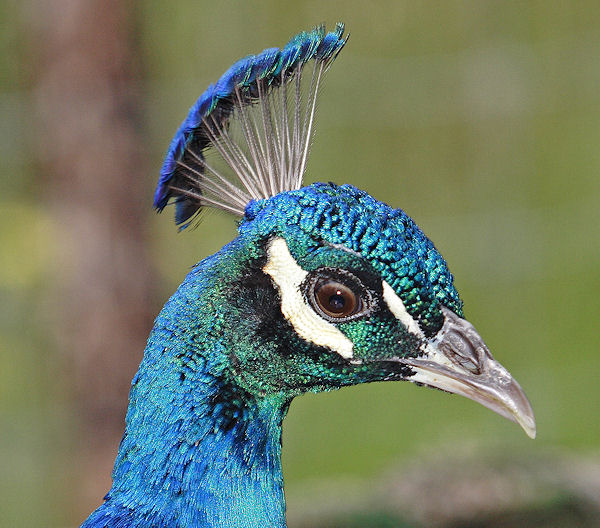
Abb.: शिखा । चूडा । Krönchen von Pavo cristatus Linnaeus 1758 - Indian Peafowl - Blauer
Pfau, Männchen
[Bildquelle: Fir0002/Flagstaffotos / Wikimedia. -- GNU FDLicense]
2.9.80. Schweif des Pfauen - Peacock's tail
|
31. c./d.
śikhā cūḍā
śikhaṇḍas tu picchabarhe napuṃsake
शिखा चूडा
शिखण्डस् तु पिच्छबर्हे नपुंसके ॥३१ ख॥
[Bezeichnungen für den Schweif des Pfauen:]
-
शिखण्ड - śikhaṇḍa m.: Haarbüschel, Locke,
Schopf, Pfauenschweif
-
पिच्छ - piccha n.: Schwanzfeder
-
बर्ह - barha n.: Schwanzfeder, Schweif
|
Colebrooke (1807): "His tail."
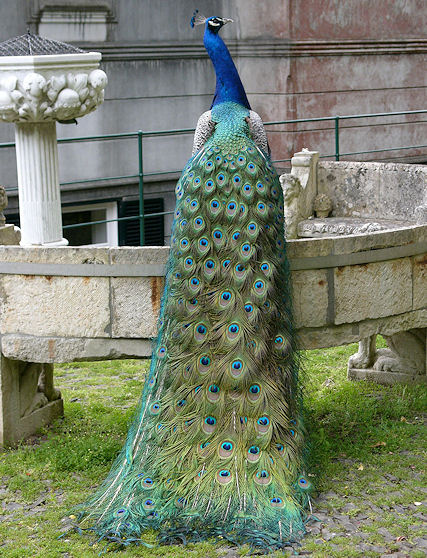
Abb.:
शिखण्डः । Schweif von Pavo cristatus Linnaeus 1758 - Indian Peafowl -
Blauer Pfau, Männchen
[Bildquelle: Amanda Grobe / Wikimedia. --
Creative
Commons Lizenz (Namensnennung, share alike)]
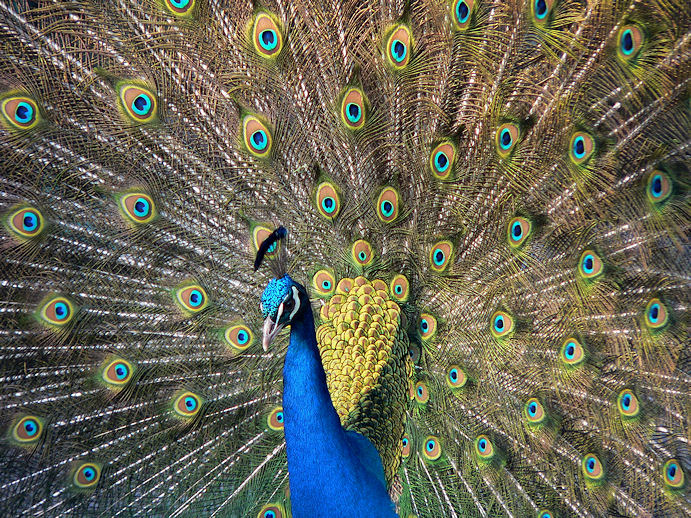
Abb.: पिच्छः । Balzendes Männchen von Pavo cristatus Linnaeus 1758 -
Indian Peafowl - Blauer Pfau, Zoo
[Bildquelle: BS Thurner Hof / Wikipedia. -- GNU FDLicense]
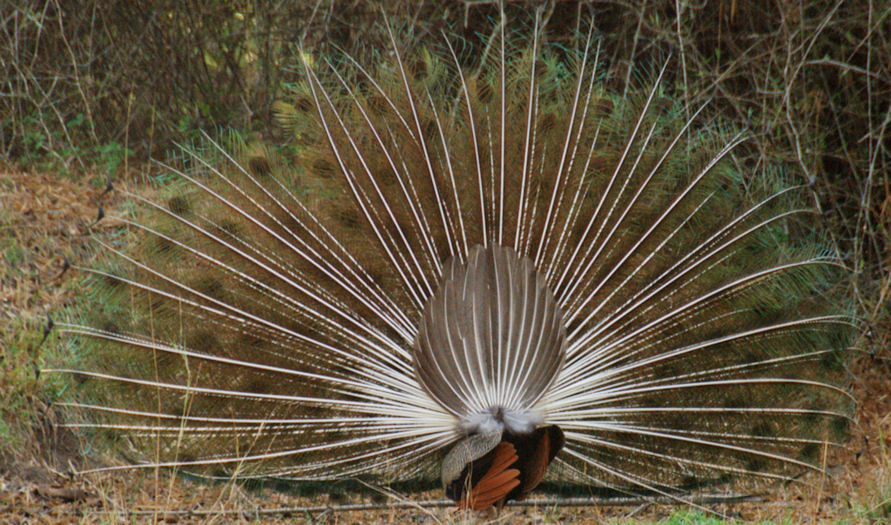
Abb.: बर्हः । Balzendes Männchen von Pavo cristatus Linnaeus 1758 -
Indian Peafowl - Blauer Pfau, von hinten, Bandipur National Park -
ಬಂಡಿಪುರ ರಾಷ್ಟ್ರೀಯ ಉದ್ಯಾನವನ, Karnataka
[Bildquelle:
Tahir Hashmi.
--
http://www.flickr.com/photos/code_martial/482605128/. -- Zugriff am
2010-12-25. --
Creative Commons Lizenz (Namensnennung, keine kommerzielle Nutzung,
share alike)]
2.9.81. Bezeichnungen für "Vogel" - "Bird"
32. khage vihaṅga-vihaga-vihaṅgama-vihāyasaḥ
śakunti-pakṣi-śakuni-śakunta-śakuna-dvijāḥ
33. patatri-patri-pataga-patat-patrarathāṇḍajāḥ
nagauko-vāji-vikira-vi-viṣkira-patatrayaḥ
34. a./b. nīḍodbhavāḥ garutmantaḥ pitsanto nabhasaṃgamāḥ
खगे विहङ्ग-विहग-विहङ्गम-विहायसः ।
शकुन्ति-पक्षि-शकुनि-शकुन्त-शकुन-द्विजाः ॥३२॥
पतत्रि-पत्रि-पतग-पतत्-पत्ररथाण्डजाः ।
नगौको-वाजि-विकिर-वि-विष्किर-पतत्रयः ॥३३॥
नीडोद्भवाः गरुत्मन्तः पित्सन्तो नभसंगमाः ।३२ क।
Bezeichnungen für खग - khaga m.: Luftgänger, Flieger, Vogel,
Planet:
-
विहङ्ग -
vihaṅga m.: in die Luft Gehender
- विहग - vihaga m.:
in der Luft Gehender, in die Luft Gehender
- विहङ्गम
- vihaṅgama m.: in die Luft Gehender
- विहायस् -
vihāyas m.: in der Luft Gehender, in die Luft Gehender
- शकुन्ति
- śakunti m.: Vogel
- पक्षिन् -
pakṣin m.: Geflügelter
- शकुनि -
śakuni m.: Vogel, bes. Milvus migrans - Pariah Kite
- शकुन्त
- śakunta m.: Vogel
- शकुन - śakuna m.:
Vogel, bes. Gyps indicus - Long-billed Vulture
- द्विज - dvija
m.: Zweimalgeborener (einmal als Ei, dann bei Schlüpfen)
- पतत्रिन्
- patatrin m.: Geflügelter
- पत्रिन् -
patrin m.: Geflügelter
- पतग - pataga m.:
Fliegender
- पतत् - patat m.:
Fliegender
- पत्ररथ
- patraratha m.: Flug-Wagen
- अण्डज
- aṇḍaja m.: Ei-Geborener
- नगौकस् - nagaukas
m.: Berg-Bewohner
- वाजिन् -
vājin m.: Flinker
- विकिर -
vikira m.: Ausstreuer, Körneropfer
- वि - vi m.: Vogel
- विष्किर
- viṣkira m.: Ausstreuer
- पतत्रिन् - patatrin
m.: Geflügelter
- नीडोद्भव -
nīḍodbhava m.: in einem Nest Entstehender
- गरुत्मत्
- garutmat m.: Geflügelter
- पित्सन्त्
- pitsant m.: der fliegen will
- नभसंगम
- nabhasaṃgama m.: in die Luft Gehender
|
Colebrooke (1807): "A bird in general."
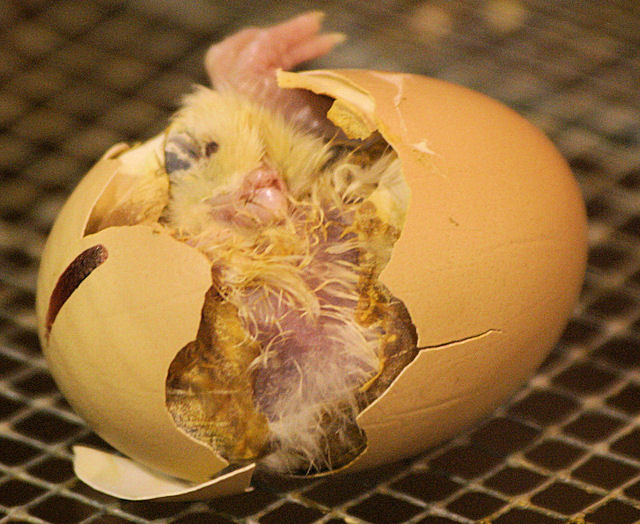
Abb.: अण्डजः
। द्विजः । Hühnchen beim Schlüpfen
[Bildquelle: grendelkhan. --
http://www.flickr.com/photos/grendelkhan/1739046816/. -- Zugriff
am 2011-01-19. --
Creative Commons Lizenz (Namensnennung, share alike)]
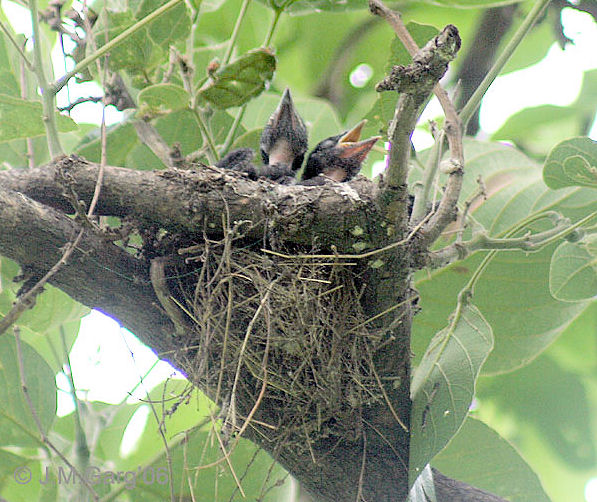
Abb.:
नीडोद्भवौ । Dicrurus macrocercus - Black Drongo,
Kolkata - কলকাতা, West
Bengal
[Bildquelle: J. M. Garg / Wikimedia. -- GNU FDLicense]
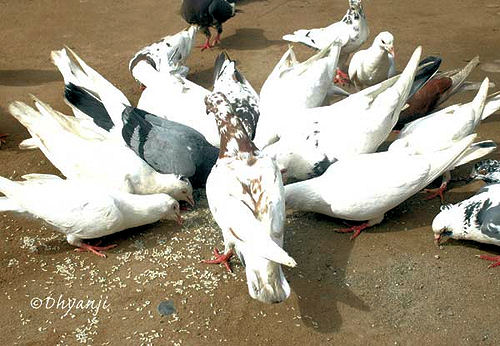
Abb.: विकिराः । विष्किराः ।
[Bildquelle: dhyanji. --
http://www.flickr.com/photos/dhyanji/201075174/. -- Zugriff am
2011-01-19. --
Creative
Commons Lizenz (Namensnennung, keine kommerzielle Nutzung, keine
Bearbeitung)]
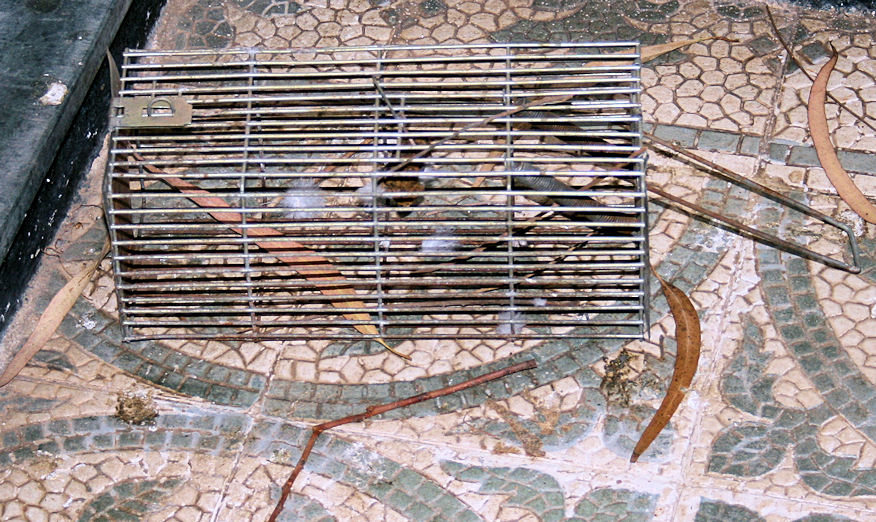
Abb.: पित्सन् । Bangalore -
ಬೆಂಗಳೂರು, Karnataka
[Bildquelle:
Frank Harris. --
http://www.flickr.com/photos/hirefrank/2333650337/. -- Zugriff am
2011-01-19. --
Creative
Commons Lizenz (Namensnennung, keine kommerzielle Nutzung, share alike)]
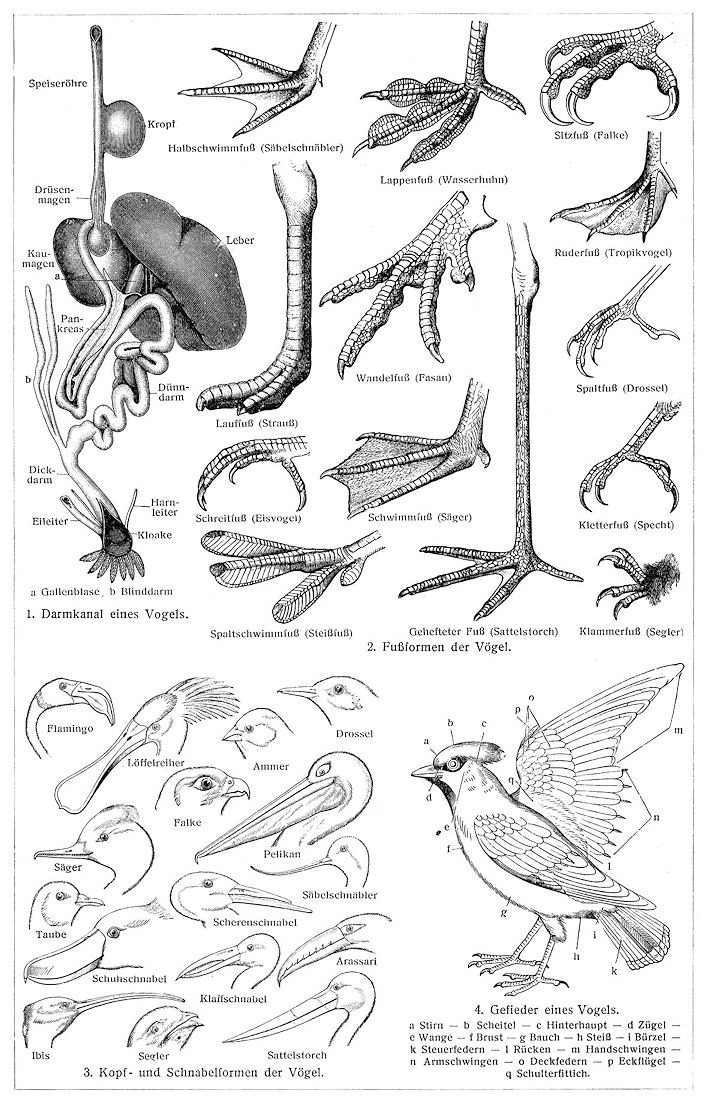
Abb.: Körperteile der Vögel
[Bildquelle: Meyers großes Konversations-Lexikon. --
DVD-ROM-Ausg. Faksimile und Volltext der 6. Aufl. 1905-1909.
-- Berlin : Directmedia Publ. --2003.
-- 1 DVD-ROM. -- (Digitale Bibliothek ; 100). -- ISBN
3-89853-200-3. -- s.v. "Vögel"]
2.9.82. Chalcophaps indica Linnaeus 1758 - Emerald Dove -
Grünflügeltaube
& Treron apicauda Blyth, 1846 - Pin-tailed Green Pigeon
& Treron sphenurus Vigors, 1832 - Wedge-tailed Green
Pigeon - Keilschwanz-Grüntaube
33 cm
|
34. c./d. teṣāṃ viśeṣā hārīto
madguḥ kāraṇḍavaḥ plavaḥ
तेषां विशेषा हारीतो मद्गुः काराण्डवः प्लवः
॥३४ ख॥
Arten von Vögeln:
हारीत -
hārīta m.: Hārīta (vielleicht zu hāra m.: Perlenschnur) = "Chalcophaps indica, Emerald Dove; esp. Treron apicauda,
Pin-tailed Green Pigeon; [Treron sphenurus Vigors, 1832] Wedgetailed Green Pigeon." (Dave, 515) |
Colebrooke (1807): [34c. - 35:] "Various birds. Severally
named in the text ; viz. Green pigeon, &c. Besides others as मत्स्यरङ्गः [matsyaraṅga],
a king-fisher, &c." [hārita:] "Columba Hurriala, B. Mss."
Chalcophaps indica Linnaeus 1758 - Emerald Dove -
Grünflügeltaube
27 cm
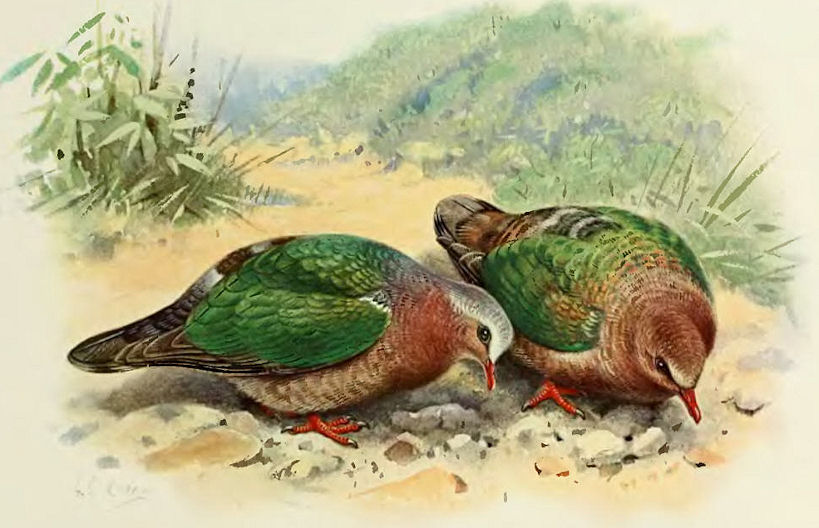
Abb.: हारीतौ । Chalcophaps indica Linnaeus 1758 - Emerald Dove -
Grünflügeltaube
[Bildquelle: Stuart Baker, E. C.: Indian pigeons
and doves. -- London, 1913. --Pl. 23]
|
"Habitat. Throughout India in forest countries and
well wooded districts ; not in the drier regions, as Sind, Rajputana,
Kattyawar, &c. It is abundant in Lower Bengal ; extends to Assam and all the
countries on the east of the Bay of Bengal as far as Tenasserim. It also
occurs in Ceylon, the Andamans, Nicobars, the Indo-Burmese Countries, South
China, Siam,the Malay Peninsula, and all the islands nearly down to Australia.
Frequents thick forests, and is met with in small parties or in pairs. Breeds
from March to July in suitable localities. The nests, according to Hume, are
placed in some dense bush or low thick-foliaged tree. They are more
regular saucers than those of other doves, composed of roots, grass, or twigs,
but comparatively neat and with a central depression. Eggs two in number, pure
white, from 1 to 1.1 inch in length and from 0.82 to 0.86 in breadth."
[Quelle: Murray, James A.:
The avifauna of British India and its dependencies. -- London : Trübner,
1888-1890. -- 2 Bde. -- Bd. 2, S. 517f.] |
|
"This beautiful Ground-dove is found
throughout India, in forest countries, occasionally in well-wooded
districts, as in Lower Bengal, extending to Assam and all the
countries on the East of the Bay of Bengal, as far as, at all events,
Tenasserim. It is very partial to bamboo jungle, and occurs
from the level of the sea up to 3,000 feet, or perhaps higher. It feeds
mostly on the ground, often on roads in forests, and bare spots
under trees, walking along with a rapid motion, and allowing a
moderately near approach. Its flight is very rapid. It is generally
seen alone. Its voice is a low plaintive moan, or 'lowing coo,'
as Layard calls it. Its eggs are said by Layard to be pale yellowish
drab color, but Blyth says that they are merely of a less pure
white than those of ordinary Pigeons or Doves. It soon becomes
reconciled to confinement, and caged birds are usually for sale in Calcutta."
[Quelle: Jerdon,
T. C. (Thomas Claverhill) <1811-1872>: The birds of India. --
Calcutta, 1862. -- Vol 2,2. -- S. 485.] |
Treron apicauda Blyth, 1846 - Pin-tailed
Green Pigeon
40 cm/35 cm

Abb.: हारीतौ । Treron apicauda Blyth, 1846 - Pin-tailed Green Pigeon
[Bildquelle: Stuart Baker, E. C.: Indian pigeons
and doves. -- London, 1913. --Pl. 6]
|
"Habitat. S.-E. Himalayas, in Nepaul and Sikkim ;
also British Burmah, in Tenasserim, extending to the hill ranges of
Eastern Bengal and Assam. Habits not unlike other pigeons. Jerdon says
its not unlike the last species, but its coo is less loud, musical and prolonged."
[Quelle: Murray, James A.:
The avifauna of British India and its dependencies. -- London : Trübner,
1888-1890. -- 2 Bde. -- Bd. 2, S. 503.] |
|
"This elegant Green Pigeon has hitherto only
been found in the South-east Himalayas, in Nepal and
Sikim, extending, however, to the hill ranges of Assam. It is
not so common near Darjeeling as the last species, and frequents
a lower zone, being found in the warmer valleys. Its note is very
similar to that of the last species, but less loud, musical, and prolonged."
[Quelle: Jerdon,
T. C. (Thomas Claverhill) <1811-1872>: The birds of India. --
Calcutta, 1862. -- Vol 2,2. -- S. 454.] |
Treron sphenurus Vigors, 1832 - Wedge-tailed
Green Pigeon - Keilschwanz-Grüntaube
33 cm
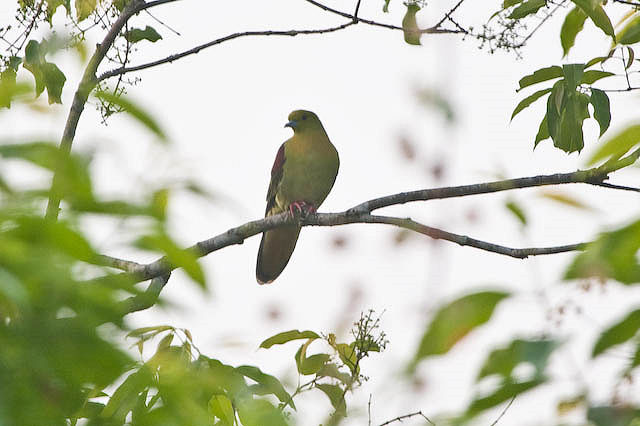
Abb.: हारीतः । Treron sphenurus Vigors, 1832 - Wedge-tailed Green
Pigeon - Keilschwanz-Grüntaube, Assam
[Bildquelle: MUKESH JAIN / Wikipedia. --
Creative Commons Lizenz (Namensnennung)]
|
"Habitat. Himalayas, extending into Assam and Sylhet, ascending as high as from 4,000 to 8,000 feet. Found also in Pegu.
Jerdon says it is common at Darjeeling, and that at Mussoorie they leave
in October and return to breed in April. Nest made on trees, composed of
twigs. Eggs two in number, pure white."
[Quelle: Murray, James A.:
The avifauna of British India and its dependencies. -- London : Trübner,
1888-1890. -- 2 Bde. -- Bd. 2, S. 502.] |
|
"The Kokla Green Pigeon is spread throughout
the Himalayas, extending into the hilly regions of Assam and
Sylhet. It frequents the zone from 4,000 to 8,000 feet, in winter
perhaps descending lower, for Hutton remarks that they leave
Mussooree in October, returning in April to breed. It is common at
Darjeeling, but, as Tickell remarks, not so extensively
gregarious as the common green pigeons of the plains. They frequent
high trees, and feed of course exclusively on fruit. Hutton found
them breeding in May and June, making the usual nest of dried
twigs, and with two white eggs.
The male has a most agreeable note, more
prolonged and musical than that of Crocopus. Blyth says of
it :—"The notes bear some resemblance to the human voice in
singing, and are highly musical in tone, being considerably
prolonged and modulated, but always terminating abruptly, and every
time the stave is repeated exactly as before, so that it
soon becomes wearisome to an European ear." After moulting in
confinement, the green colour, in some specimens, becomes replaced
by a delicate pearl grey, and the russet tinge of the head and
breast becomes pale maronne. Mr. Blyth, described a caged
specimen with these tints as V. cantillans.
The Kokhila is greatly prized as a cage-bird
by the natives, and is occasionally brought for sale to
Calcutta, and sells at a high price."
[Quelle: Jerdon,
T. C. (Thomas Claverhill) <1811-1872>: The birds of India. --
Calcutta, 1862. -- Vol 2,2. -- S. 453f.] |
2.9.83. Anhinga melanogaster Pennant, 1769 -
Oriental Darter - Altwelt-Schlangenhalsvogel
90 cm
|
34. c./d. teṣāṃ viśeṣā
hārīto
madguḥ
kāraṇḍavaḥ plavaḥ
तेषां विशेषा
हारीतो मद्गुः काराण्डवः प्लवः ॥३४ ख॥
मद्गु -
madgu m.: Madgu (zu majj 1: tauchen) = "Anhinga rufa, Darter (or Snakebird)." (Dave, 505) |
Colebrooke (1807): "A shag."
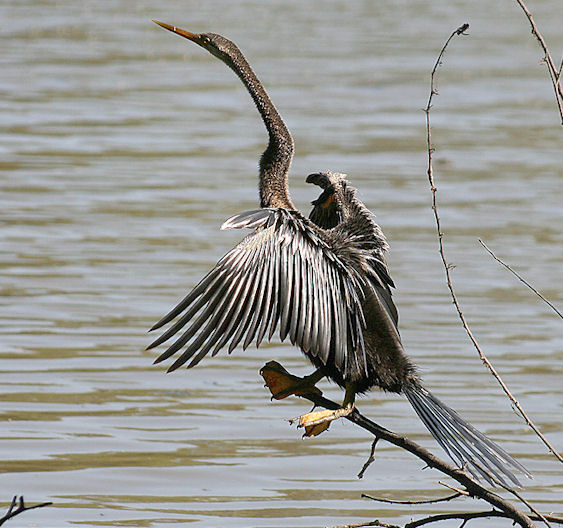
Abb.: मद्गुः । Anhinga melanogaster Pennant, 1769 - Oriental Darter -
Altwelt-Schlangenhalsvogel, Bharatpur -
भरतपुर,
Rajasthan
[Bildquelle: J. M. Garg / Wikimedia. -- GNU FDLicense]
|
"Habitat. Sind, Bengal, Rajputana, Kutch, Guzerat,
Concan, Deccan and India generally ; also Burmah and Ceylon,
extending to the Malay Peninsula. Breeds in Sind and wherever found from June
to December in large societies. Eggs, white or bluish white, with a chalky coat."
[Quelle: Murray, James
A.:
The avifauna of British India and its dependencies. -- London :
Trübner, 1888-1890. -- 2 Bde. -- Bd. 2, S. 742.] |
|
"This beautiful diver is found throughout all
India, Ceylon, Burmah, and Malayana. It is exceedingly
numerous in some parts of the country, especially in Bengal ;
hundreds are often to be seen on a single jheel. They hunt singly
in general, or in scattered parties, but often roost in company,
both at night and in the middle of the day, when numbers may be
seen perched on the trees overhanging some tank or river.
They float low on the water, often with nothing, but the
head and neck visible, and swim and dive with rapidity. After
feeding for some time, they perch on the bough of a tree, or on a
pole or stone, and spread their wings out to dry as the Cormorants do.
They feed on fish, and their digestion is very rapid. They
nidificate on trees, but I have not procured their eggs.
The lengthened scapular feathers are looked
on as a badge of Royalty by the Khasias, and they are esteemed
by all. They were the badge of one of the Bengal regiments
of Irregular Cavalry."
[Quelle: Jerdon,
T. C. (Thomas Claverhill) <1811-1872>: The birds of India. --
Calcutta, 1862. -- Vol 2,2. -- S. 866.] |
2.9.84. Fulica atra Linnaeus, 1758 - Eurasian Coot -
Blässhuhn
& Anas platyrhynchos Linnaeus, 1758 -
Mallard - Stockente
& Mergus merganser Linnaeus, 1758 - Common
Merganser - Gänsesäger
|
34. c./d. teṣāṃ viśeṣā
hārīto madguḥ
kāraṇḍavaḥ
plavaḥ तेषां
विशेषा हारीतो मद्गुः काराण्डवः प्लवः
॥३४ ख॥
काराण्डव
-
kāraṇḍava m.: Kāraṇḍava = "Fulica atra, (Common) Coot; a generic term for Swans,
Geese, Ducks, Mergansers; Anas plathyrhynchos, Mallard (or Wild Duck);
Mergus merganser, Common Merganser (Eastern Goosander)." (Dave, 488) |
Colebrooke (1807): "Sort of duck."
Fulica atra Linnaeus, 1758 - Eurasian Coot - Blässhuhn
42 cm
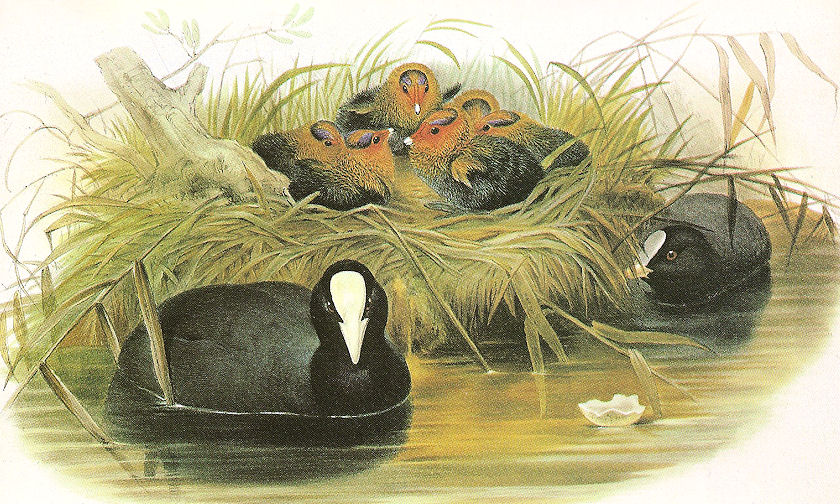
Abb.: काराण्डवाः । Fulica atra Linnaeus, 1758 - Eurasian Coot - Blässhuhn
[Bildquelle: Gould, Birds of Great Britain, 1862 - 1873]
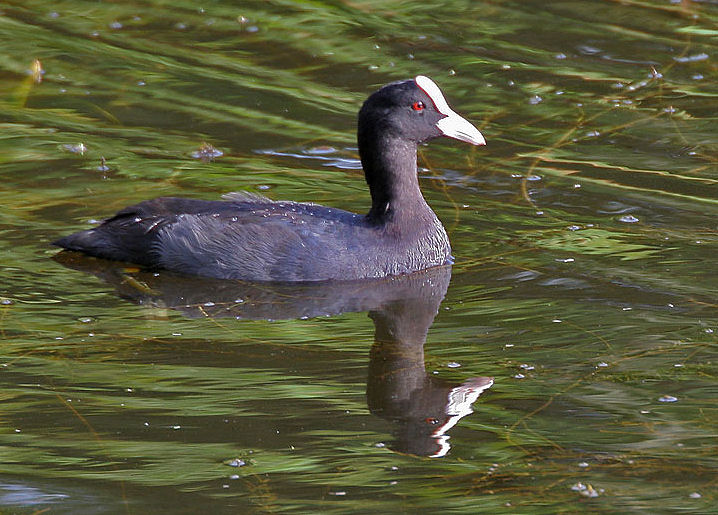
Abb.: काराण्डवः । Fulica atra Linnaeus, 1758 - Eurasian Coot - Blässhuhn,
Hyderabad - హైదరాబాద్, Andhra
Pradesh
[Bildquelle: J. M. Garg / Wikimedia. -- GNU FDLicense]
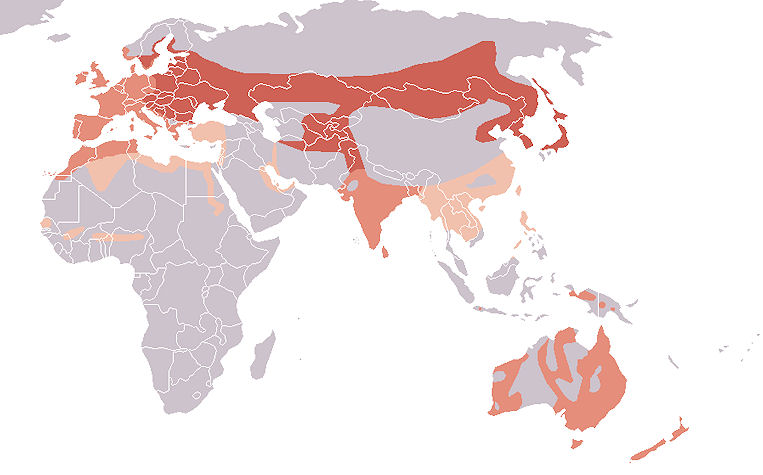
Abb.: काराण्डवः । Lebensräume von Fulica atra Linnaeus, 1758 - Eurasian
Coot - Blässhuhn
[Bildquelle: Viktor Kravtchenko / Wikipedia. -- GNU FDLicense]
|
"Habitat. Throughout India, Ceylon and British Burmah ; also Europe (central and south), Egypt, Assam, Nepaul, Persia,
Beloochistan and Afghanistan. In Sind it is numerous in suitable localities,
but on the Munchur Lake, as Mr. Hume says (Str. F. vol. i. 249) "they would
have to be counted not by thousands, but by hundreds of thousands. * *
* You can shoot nothing without knocking over some of these wretched
coots." He also adds " that in no part of the world has he even seen such
incredible multitudes of coot as are met with in Sind ; in the Munchur Lake par excellence.""
[Quelle: Murray, James A.:
The avifauna of British India and its dependencies. -- London : Trübner,
1888-1890. -- 2 Bde. -- Bd. 2, S. 636f.] |
|
"The Coot is common in most parts of India,
rare or wanting in some localities which seem perfectly
adapted for it. It is found throughout Europe, Asia, and Northern Africa.
It prefers weedy tanks, is found in considerable flocks,
and is often seen in the middle of the day resting on the water in
the middle of some large tank, far away from any weeds or cover.
When first raised it appears to fly with difficulty,
striking the surface of the water for many yards, but when fairly on
the wing, it can fly tolerably well. It sometimes travels great
distances, for it is often found on tanks that dry up during the hot
weather. It dives well.
The Coot feeds chiefly on vegetable matter,
seeds, and shoots of aquatic plants. It is a noisy bird at times,
having a peculiar call. It makes a large nest, occasionally fixed, at
other times of floating weeds, and lays six to eight eggs, of stone
or reddish-grey color, with small red and dark brown speckles.
Burgess states that some young birds he procured had bright
orange hair-like feathers over part of their bodies.
Several species of Coots are recorded from
all parts of the world."
[Quelle: Jerdon,
T. C. (Thomas Claverhill) <1811-1872>: The birds of India. --
Calcutta, 1862. -- Vol 2,2. -- S. 716.] |
Anas platyrhynchos Linnaeus, 1758 - Mallard - Stockente
61 cm
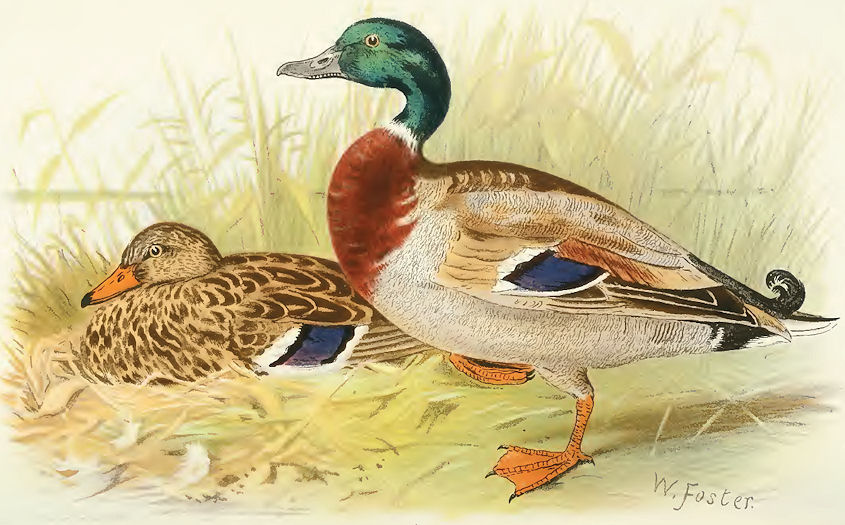
Abb.: काराण्डवौ । Anas platyrhynchos Linnaeus, 1758 - Mallard - Stockente
[Bildquelle: Indian sporting birds. -- 1915.]
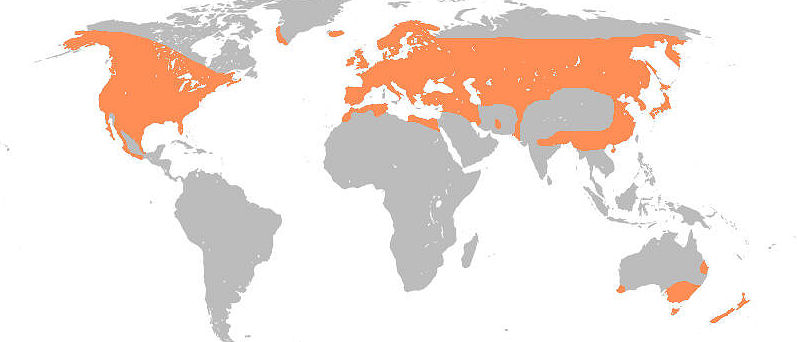
Abb.: काराण्डवः । Lebensräume von Anas platyrhynchos Linnaeus, 1758 -
Mallard - Stockente
[Bildquelle: FR / Wikipedia. -- GNU FDLicense]

Klicken! Ruf von Anas platyrhynchos Linnaeus, 1758 -
Mallard - Stockente, Italien
[Quelle der .ogg-Datei: Dr. Marco Dragonetti / Wikimedia. --
Creative Commons Lizenz (Namensnennung, share alike)]
|
"Habitat. Sind, Beloochistan,
Persia, Afghanistan, Punjab, N.-W. and Central Provinces, Oudh,
Bengal, Rajputana, Kutch, Guzerat, the Concans, and a straggler in
the Deccan."
[Quelle: Murray, James A.:
The avifauna of British India and its dependencies. -- London : Trübner,
1888-1890. -- 2 Bde. -- Bd. 2, S. 684.] |
|
"The Mallard is apparently not very rare in
the North of India, especially in the North-west, but I have
never seen it South of the Nerbudda, und have only shot it myself near
Mhow, and lately in Kumaon. It has not yet occurred in Bengal.
It appears to remain all the year in Cashmere, and to breed
in that country, as Theobald found the eggs there in May. It is
found throughout the Northern Hemisphere, breeding in
temperate regions. It is one of the best Ducks for the table, and, as
is well known, is the origin of our domestic Duck."
[Quelle: Jerdon,
T. C. (Thomas Claverhill) <1811-1872>: The birds of India. --
Calcutta, 1862. -- Vol 2,2. -- S. 798f.] |
Mergus merganser Linnaeus, 1758 - Common Merganser -
Gänsesäger
66 cm
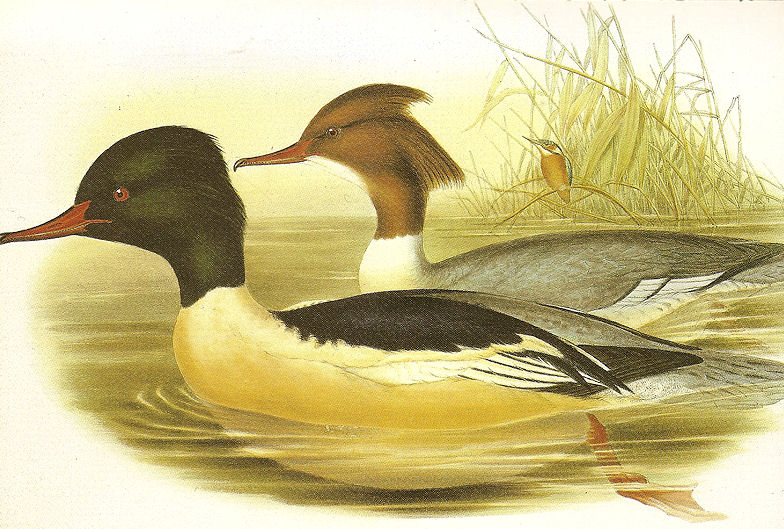
Abb.: काराण्डवौ । Mergus merganser Linnaeus, 1758 - Common Merganser -
Gänsesäger
[Bildquelle: Gould, Birds of Great Britain, 1862 - 1873]

Abb.: काराण्डवौ । Mergus merganser Linnaeus, 1758 - Common Merganser -
Gänsesäger, Pärchen, Deutschland
[Bildquelle: HBD / Wikiepedia. -- GNU FDLicense]

Abb.: काराण्डवः । Lebensräume von Mergus merganser Linnaeus, 1758 -
Common Merganser - Gänsesäger
(gelb: Sommer, blau: Winter, grün: das ganze Jahr)
[Bildquelle: Andreas Trepte / Wikipedia. --
Creative Commons Lizenz (Namensnennung, share alike)]
|
"Habitat. This species, although not yet reported
from Sind, will no doubt be found to occur. It is said to occur in the
Punjab, N.-W. Provinces, and Bengal, and also in Ajmere, and to breed in
the higher valleys of the Himalayas, and in Beloochistan and Persia."
[Quelle: Murray, James A.:
The avifauna of British India and its dependencies. -- London : Trübner,
1888-1890. -- 2 Bde. -- Bd. 2, S. 706.] |
|
"The Merganser is chiefly found, in India, on
rivers within the Himalayas, in small parties. I have
frequently seen it on the great Rungeet in Sikkim, and also in rivers in
Kumaon, and on the Ganges at Hurdwar. One instance only is
recorded of its occurrence in Central India, it having been procured by
Tickell at Chybassa. Captain Smyth recently gave me two
very large concretions found in one of these birds, but I have not
yet had them examined. It is said to breed on holes of trees."
[Quelle: Jerdon,
T. C. (Thomas Claverhill) <1811-1872>: The birds of India. --
Calcutta, 1862. -- Vol 2,2. -- S. 818.] |
2.9.85. Phalacrocoracidae - Comorants - Kormorane
|
34. c./d. teṣāṃ viśeṣā
hārīto madguḥ kāraṇḍavaḥ
plavaḥ तेषां
विशेषा हारीतो मद्गुः काराण्डवः प्लवः ॥३४ ख॥
प्लव -
plava m.: "Schwimmer" = "any of the Phalacrocoracidae (Comorant)." (Dave, 503) |
Am verbreitetsten sind in Indien:
- Phalacrocorax carbo Linnaeus, 1758 - Great Comorant -
Kormoran
- Phalacrocorax niger Vieillot, 1817 - Little Comorant
- Mohrenscharbe
Phalacrocorax carbo Linnaeus, 1758 - Great Comorant - Kormoran
80 cm
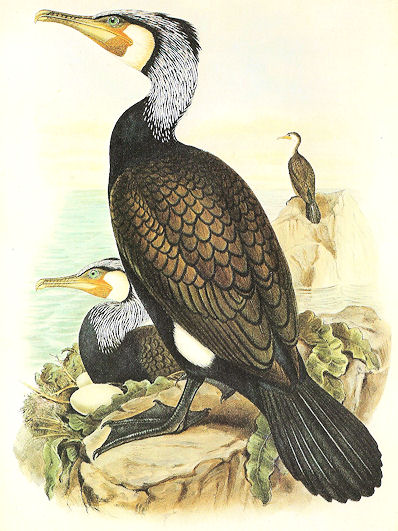
Abb.:
प्लवाः ।
Phalacrocorax carbo Linnaeus, 1758 - Great Comorant - Kormoran
[Bildquelle: Gould, Birds of Great Britain, 1862 - 1873]
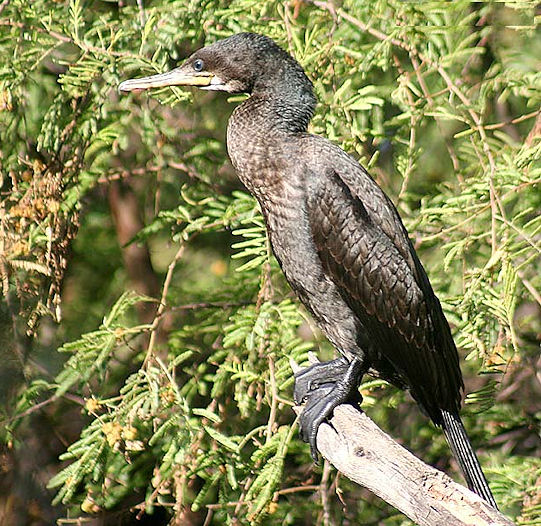
Abb.: प्लवः
। Phalacrocorax carbo Linnaeus, 1758 - Great Comorant - Kormoran,
Bharatpur - भरतपुर,
Rajasthan
[Bildquelle: J. M. Garg / Wikimedia. -- GNU FDLicense]
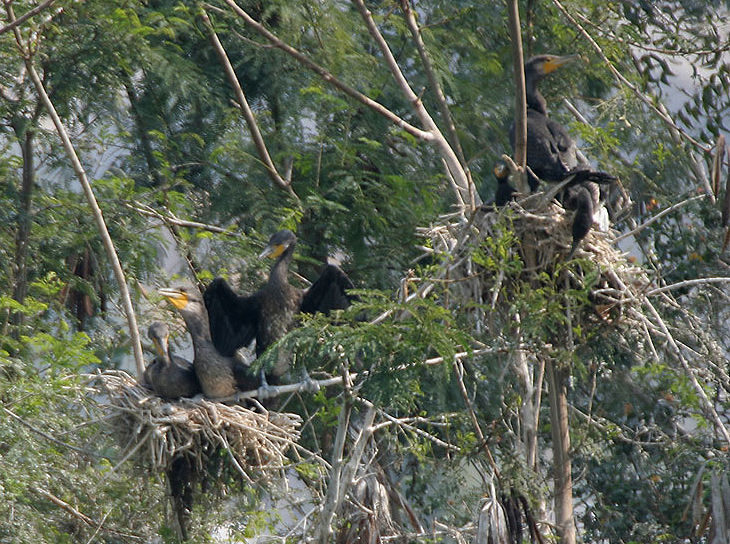
Abb.: प्लवाः । Phalacrocorax carbo Linnaeus, 1758 - Great Comorant - Kormoran,
nistend, Hyderabad - హైదరాబాద్, Andhra
Pradesh
[Bildquelle: J. M. Garg / Wikimedia. -- GNU FDLicense]
|
"Habitat. Sind, N.-West Provinces, Western and
Central India, also Beloochistan and Persia, extending to Eastern Turkestan,
Nepaul and Cashmere. Distribution almost universal.
Breeds wherever found. In Sind in the middle
of the Samara Dhund in the Eastern Narra Districts. Nest a platform of
sticks, lined with grass and rushes. Eggs 4 to 6 in number, white or greenish
white, glossless, and of a chalky texture.
Whether on sea or on the inland lakes,
Cormorants make terrible havoc among the fishes inhabiting the waters they
affect. Sometimes, though seldom so seen, they swoop down from mid air on the
object of their prey, and pursue it under the surface of the water with
great dexterity and unerring certainty. They, however, must necessarily
rise to the surface to swallow their prey, and this trait no doubt has led
to their being trained by fishermen for the purpose of catching fish. In Sind as
well as in China and other countries fishermen always have a dozen or
more of these birds sitting, when not employed, lazily on the cross beam of the
prow of their boats, quite sullen and stern; the whole deportment of the bird
gives it the aspect of an unrelenting tyrant.
In fishing a leathern collar is put round
their necks, to prevent the fish being swallowed, and it is said the fishermen
in Sind make a livelihood by the amount of fish caught by Cormorants when
their nets fail. They are not, however, hooded, as falcons are, when unemployed."
[Quelle: Murray, James A.:
The avifauna of British India and its dependencies. -- London : Trübner,
1888-1890. -- 2 Bde. -- Bd. 2, S. 739.] |
|
"The large Cormorant of Britain is found
throughout India, is more rare towards the south, and is there
chiefly found in rivers that run through forest and hilly ground, but
occasionally occurs in large tanks in the open country. In the
north of India it appears more common, especially in the well-watered
province of Bengal where it chiefly frequents rivers, and on
rivers within the Himalayas. It is rather strange that it is not included
in Gray's List of Hodgson's Nepal Birds. It is very generally
found in pairs or singly, occasionally four or five together. I
am not aware if it breeds in this country, but it probably does
so in suitable spots.
The Cormorant is found over all Europe, Asia,
and great part of Africa."
[Quelle: Jerdon,
T. C. (Thomas Claverhill) <1811-1872>: The birds of India. --
Calcutta, 1862. -- Vol 2,2. -- S. 861f.] |
Phalacrocorax niger Vieillot, 1817 - Little Comorant -
Mohrenscharbe
51 cm
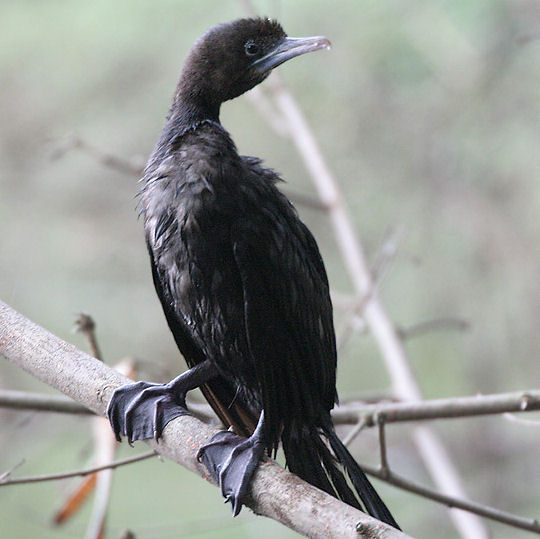
Abb.: प्लवः
। Phalacrocorax niger Vieillot, 1817 - Little
Comorant - Mohrenscharbe, Brutkleid, Kolkata -
কলকাতা, West
Bengal
[Bildquelle: J. M. Garg / Wikimedia. -- GNU FDLicense]
| "Habitat. Sind, Punjab, N.-W. Provinces, Kutch, Guzerat, Rajputana, Concan, the Deccan, Burmah and Ceylon. Breeds
wherever found from August to December according to locality."
[Quelle: Murray, James A.:
The avifauna of British India and its dependencies. -- London : Trübner,
1888-1890. -- 2 Bde. -- Bd. 2, S. 740.] |
|
"The Little Cormorant is exceedingly common in
every part of India, frequenting alike rivers, lakes, tanks,
and pools of water by the road side, and is very tame and fearless.
It hunts singly or in pairs, or in small scattered parties,
but collects in numerous flocks for roosting, on trees overhanging the
water, or occasionally in large beds of reeds. It breads on trees,
occasionally in the midst of villages, having numerous nests on
the same tree, and laying four or five pale green eggs."
[Quelle: Jerdon,
T. C. (Thomas Claverhill) <1811-1872>: The birds of India. --
Calcutta, 1862. -- Vol 2,2. -- S. 864.] |
2.9.86. Francolinus francolinus Linnaeus, 1766
- Black Francolin - Halsbandfrankolin
34 cm
|
35 a./b. tittiriḥ
kukkubho lāvo jīvañjīvaś cakorakaḥ
तित्तिरिः कुक्कुभो लावो जीवञ्जीवश् चकोरकः
।३५ क।
तित्तिरि
- tittiri m.: Tittiri ("wohl onomatopetisch nach einem Geräusch beim Fliegen" PW)
= "Francolinus francolinus, Black Partridge
(Black Francolin)." (Dave, 497) |
Colebrooke (1807): "The francoline Partridge."
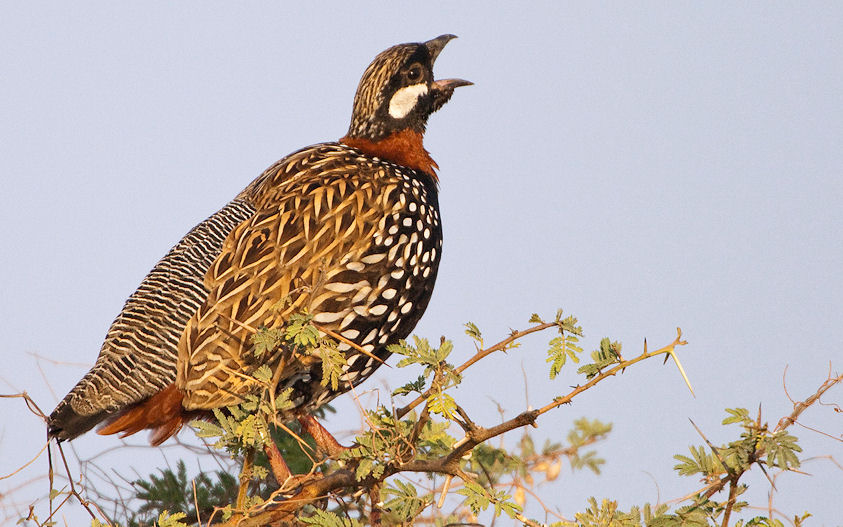
Abb.:
तित्तिरिः । Francolinus francolinus Linnaeus, 1766
- Black Francolin - Halsbandfrankolin, Rann of Kutch -
કચ્છનું મોટું રણ,
Gujarat
[Bildquelle:
Tarique Sani. --
http://www.flickr.com/photos/tariquesani/4329762364/. -- Zugriff am
2010-12-25. --
Creative
Commons Lizenz (Namensnennung, keine kommerzielle Nutzung, share alike)]
| "Habitat. The whole of Northern India from the
Himalayas to the valley of the Ganges ; also the Punjab. Southwards,
through Rajpootana to Sind. Eastwards, through Dacca to Assam, Sylhet and Tipperah.
Breeds in suitable localities, wherever it occurs, during July
and August, laying from six to ten eggs, unspotted fawn brown in colour, varying
in size from 1.42 to 1.8 in length and 1.22 to 1.38 in breadth. It frequents, by
preference, grass meadows near water ; also cultivated fields of corn,
mustard or pulse, and any patch of moderately high green herbage. In Sind it affects low
tamarisk jungle and wheat fields. Its call in the early mornings is
unmistakable, and is always made from some little eminence, as an ant hill or
the stump of a tree. It affords good sport with a pointer, and is tolerably
good eating, but, like all the Tetraonidae, is best cold, and after at least 36 hours."
[Quelle: Murray, James A.:
The avifauna of British India and its dependencies. -- London : Trübner,
1888-1890. -- 2 Bde. -- Bd. 2, S. 551.] |
|
"The black Partridge is found throughout the
whole of Northern India, from the Himalayas to the valley of
the Ganges, but not that I am aware of, extending to any distance
beyond the valley of the Ganges until above Allahabad, beyond
which it passes to the Punjab, and southwards, through Rajpootana to
Sindh and perhaps to Goozrat. Eastwards it extends through
Dacca to Assam, Sylhet and Tipperah, but I have seen no
record of its occurrence further south in this direction, and it is
replaced in Burmah by an allied species. It occurs south of the
Ganges between that river and the Hooghly, and I have seen
notices of the black Partridge having been shot in Midnapore and
Cuttack, but it is certainly rare, south of the Ganges. Various
notices appear in several pages of the Bengal Sporting Magazine
of Black Partridges occurring in the Saugor and Nerbudda
territories, Mhow and Bundelkund ; but in these instances, it has
certainly been confounded with the nearly related Painted Partridge, as
the Black Partridge does not, to my own knowledge, occur for many
miles north of Mhow, Saugor or Jubbulpore, and I suspect not
till the valley of the Jumna is reached. Adams says that the
Black Partridge is plentiful in Bombay and Bengal, but as he
does not give the Painted Partridge at all, he has in some
instances, at all events, confounded it with that bird. The
Black Partridge extends along the valleys of the Himalayas for some
distance in the interior, but not ascending high ; and I
observed it on the Khasia hills at nearly 4,000 feet of elevation. The
Black Partridge from Sindh is put as distinct by Bonaparte under
the name of F. Henrici, and a drawing of the Sindh bird in
Sir A. Burnes' collection gave some color to the separation, but Sir
B. Frere, to whom I applied, having sent several specimens from
Sindh, they proved to be perfectly identical with the Partridge
of Bengal. Out of India the Black Partridge inhabits Northern
Africa and the South of Europe, especially Malta, Sicily,
and probably part of Western Asia.
The Black Partridge frequents, by preference,
grass meadows near water, also cultivated fields of corn,
mustard or pulse, and any patch of moderately high, green herbage,
also occasionally jhow jungle ; and it is not unfrequently
flushed in moderately long grass interspersed with bushes, even at
some little distance from water. It never associates in regular
coveys, though several may be flushed not far from each other ; and,
indeed, it is generally to be found in pairs at all seasons.
From January to August, the call of the
Cock-bird may be heard, a harsh sort of cry which has been
variously rendered by sounds in different languages ; but these
imitations, thoughintelligible to those who have heard the
call, fail to give anything like a correct idea to a person who has not
had the opportunity of hearing it. The Mussulmans say
that it repeats the pious words, ' Sobhan teri kudrut;' others
say it calls out 'Lussun, piaz, udruk,' or garlic, onions,
ginger. Adams syllabizes it as ' Lohee-uha-which-a-whick', and some
one else puts it as 'juk-juk, tee-teetur.' One writer calls it
like the harsh grating blast of a cracked trumpet ; but it is far
from being a loud call, though sufficiently audible for a great
distance. This call is almost always uttered from a slight eminence,
a bank, anthill or clump of earth, and where it abounds,
answering cries may be heard from all sides. It generally calls much
after rain, or after a heavy dew.
The hen Partridge breeds from May to July,
laying ten or twelve eggs (sometimes, it is stated, as many
as fifteen) of a pale bluish white colour, according to some
writers, but those I have seen were pale greenish, when first
laid ; and she usually has her nest in the grass, sometimes in an
Indigo field, and occasionally in a Sugar-cane field.
In the cold weather, after the young have
flown and separated from their parents, they may be found
scattered over a greater expanse of country than in the hot weather
and rains, and are often to be found in fields far from water.
This Partridge is stated occasionally to perch on and to roost
on trees, but this is certainly a rare habit with this species,
though not uncommon with the Painted Partridge.
The Black Partridge is strong on the wing,
but flies steadily and affords a fair shot. Its pursuit is a
favorite sport in many parts of the country where it is at all abundant. It
is stated in the Bengal Sporting Magazine, for 1841, that
seventy-five brace have been bagged in one day by one gun, near Kurnal in
the Upper Provinces, but it is now everywhere more scarce than it
used to be formerly. It is tolerably good eating, especially when
kept for a few days and eaten cold. In some parts of the country
tippets used to be made of the beautiful black, white-spotted
feathers of the lower plumage, and were in much request, but they are rarely procurable
now."
[Quelle: Jerdon,
T. C. (Thomas Claverhill) <1811-1872>: The birds of India. --
Calcutta, 1862. -- Vol 2,2. -- S. 559ff.] |
2.9.87. Centropus sinensis Stephens, 1815 - Greater Coucal
& Centropus [sinensis] parroti - 'Southern' Coucal - Chinesischer Spornkuckuck
48 cm
|
35 a./b. tittiriḥ
kukkubho
lāvo jīvañjīvaś cakorakaḥ
तित्तिरिः
कुक्कुभो लावो जीवञ्जीवश् चकोरकः ।३५ क।
कुक्कुभ - kukkubha m.: Kukkubha = "Centropus sinensis, (Greater) Coucal."
(Dave, 489) |
Colebrooke (1807): "A wild cock, (Phasianus Gallus):"
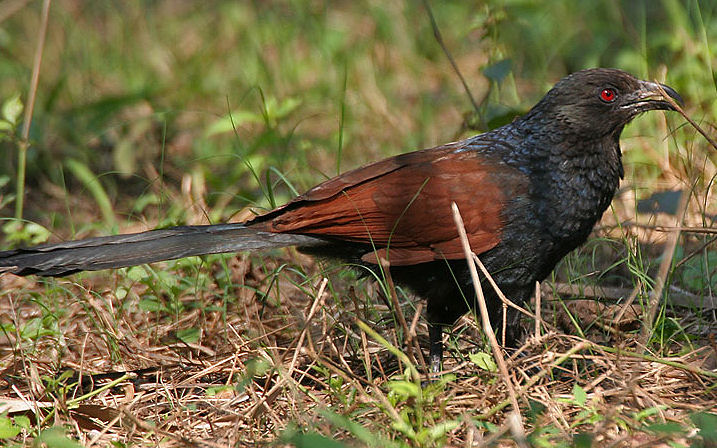
Abb.:
कुक्कुभः ।
Centropus sinensis Stephens, 1815 - Greater Coucal, Kolkata
- কলকাতা, West Bengal
[Bildquelle: J. M. Garg / Wikimedia. -- GNU FDLicense]
|
"Habitat. India generally, frequenting wooded and
cultivated localities, especially along the banks of rivers and on the edges of
cultivation, where it captures mice, snakes, worms, rats, lizards,
and other insects, upon which it feeds. This is the diet of all the members.
All the species build a large, globular, open,
or domed nest in the middle of thick, thorny bushes or trees. The nest is
usually made of dry sticks or twigs lined with a few green leaves. The hole for
entrance and exit is made on one side. June to August are the months in
which they lay. The eggs are from 2 to 5 in number, oval, and measure from
1.3 to 1.55 inch in length, and from 1.12 to 1.25 inch in breadth. In texture
they are coarse and chalky and of a dull white colour, sometimes with a pale yellowish
glaze."
[Quelle: Murray, James A.:
The avifauna of British India and its dependencies. -- London : Trübner,
1888-1890. -- 2 Bde. -- Bd. 2, S. 423.] |
|
"The 'Crow-pheasant,' as it is popularly
called in India, is a very common and universally spread bird throughout
the entire country, extending through all the Burmese provinces,
Malayana, and the isles. It frequents wooded and cultivated
grounds, edges of paddy fields, open spaces in the jungles,
beds of rivers and dry nullahs, and particularly sides of
hedge-rows, whence its Tamul and Telugu names. It feeds chiefly on
the ground, on which it walks and even runs with facility.
It eats various large insects, centipedes, scorpions,
lizards, and small snakes, also slugs, caterpillars, &c. I was informed by a
good shikaree that it occasionally pilfers eggs from the nests
of other birds. It makes its way through trees, readily running
up the boughs with considerable celerity, often elevating
its large tail, and climbing or hopping among the branches ; whence, if
followed or observed, it makes its way out at the opposite side of
the tree. When seen in tolerably open ground, with only a
few trees or bushes about, it is easily caught, being a stupid
bird and of slow flight, and a horseman will easily ride it down in
the open plain. It has a loud deep sonorous call, like whoot, whoot,
whoot, repeated slowly several times in succession. It is said to
inflate its throat to a great degree whilst uttering this sound, at
the same time bending down the head and elevating the tail. The
young bird, Mr. Blyth remarks, almost constantly repeats a strange
hoarse sound like a person choking, or sort of guk-kop-kop. When
alighting on a branch of a tree, and sometimes when it
alights on the ground, it raises its tail over its back. It makes a
large nest of twigs, or grasses, or green flag-leaves, domed at the
top, and the aperture on the side, and lined with dried leaves. It is
usually placed in the most dense and inaccessible thickets. The
eggs are two to five in number, pure white and oval. Burgess says
that the exterior of the shell is very soft, and of a chalky
texture, easily getting scratched or stained. This, as Mr. Blyth
remarks, shows an affinity to the eggs of Crotophaga, which are white,
rough and chalky externally ; but if this layer be detached,
the egg is shewn to be deep blue. It breeds from January to July,
according to the locality."
[Quelle: Jerdon,
T. C. (Thomas Claverhill) <1811-1872>: The birds of India. --
Calcutta, 1862. -- Vol 1. -- S. 349f.] |
2.9.88. Turnix sp. - Buttonquails - Laufhühnchen
& Perdicula sp. - Bush-quails - Frankolinwachteln
|
35 a./b.
tittiriḥ kukkubho
lāvo
jīvañjīvaś cakorakaḥ
तित्तिरिः कुक्कुभो लावो जीवञ्जीवश्
चकोरकः ।३५ क।
लाव - lāva m.: "Schnitter" = "may been used to refer to any of the Turnicidae
(Bustard Quail <Button Quail>); smaller than the Common or Grey
Quail (Coturnix coturnix), Bush Quails came to be
regarded as varieties of lāva." (Dave, 509) |
Colebrooke (1807): "Sort of quail, (Perdix Chinensis)."
D. h.
- Turnix suscitator Gmelin, 1789 - Barred Buttonquail -
Binden-Laufhühnchen
- Turnix tanki Blyth, 1843 - Yellow legged Buttonquail -
Rotnacken-Laufhühnchen
- Turnix sylvaticus Desfontaines, 1787 - Small Buttonquail -
Laufhühnchen
Und:
- Perdicula erythrorhyncha Sykes, 1832 - Painted Bush-quail
- Perdicula asiatica Latham, 1790 - Jungle Bush-quail -
Frankolin-Wachtel
- Perdicula argoondah Sykes, 1832 - Rock Bush-quail
Turnix suscitator Gmelin, 1789 - Barred Buttonquail -
Binden-Laufhühnchen
15 cm
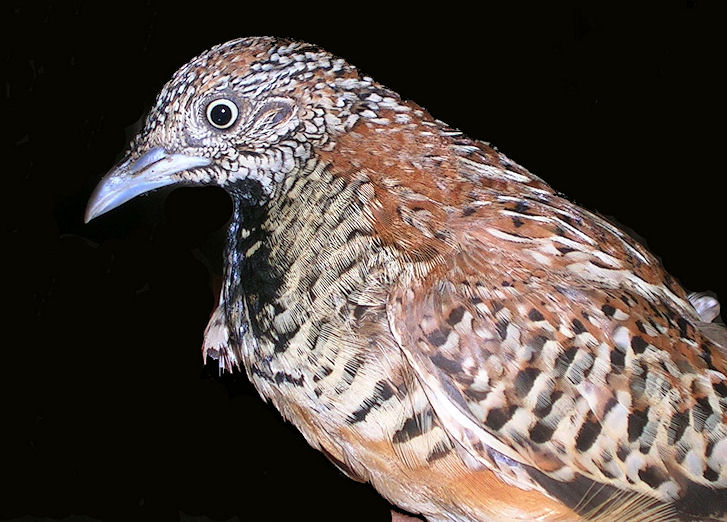
Abb.: लावः । Turnix suscitator Gmelin, 1789 - Barred Buttonquail -
Binden-Laufhühnchen, Hessarghatta Lake -
ಹೆಸರಘಟ್ಟ ಕೆರೆ, Karnataka
[Bildquelle: L. Shyamal / Wikipedia. --
Creative Commons
Lizenz (Namensnennung, share alike)]
|
"Habitat. Throughout India nearly (except Sind,
Kathiawar and Jodhpoor, and other similar dry places), extending to
Ceylon, Burmah, the Malay Peninsula, Siam, and Cochin-China. It frequents gardens,
land covered with grass, also bushes, roadsides, &c. Breeds in July
and August, wherever it occurs, laying 4 - 6 eggs, of a stone grey colour, interspersed with small specks of brown interspersed with larger spots of a neutral tint."
[Quelle: Murray, James A.:
The avifauna of British India and its dependencies. -- London : Trübner,
1888-1890. -- 2 Bde. -- Bd. 2, S. 569.] |
|
"The black-breasted Bustard-quail affects
grassy patches in the forests and jungles ; also low bushy jungle,
and is frequently to be found in fields of Chili, Dhal, and
various dense crops, especially if near patches of jungle ; for in open and
barren country, or very highly cultivated country without jungle, it
is comparatively rare. Occasionally small bevies of five or six are
flushed together, but in general, it is put up singly, or two or
three birds together. It feeds on grain of various kinds, but also
very much on small insects, larvae of grasshoppers and the like.
The female has a peculiar loud purring call which must be
familiar to many. The hen-birds are most pugnacious, especially
about the breeding season, and this propensity is made
use of, in the south of India, to effect their capture. For this
purpose a small cage with a decoy bird is used, having a
concealed spring compartment, made to fall by the snapping of
a thread placed between the bars of the cage. It is set on
the ground in some thick cover carefully protected. The
decoy-bird begins her loud purring call which can be heard a long way
off, and any females within ear-shot run rapidly to the spot, and
commence fighting with the caged bird, striking at the bars.
This soon breaks the thread, the spring-cover falls, ringing a
small bell at the same time by which the owner, who remains
concealed near at hand, is warned of a capture ; and he runs up,
secures his prey and sets the cage again in another locality. In this way I
have known twelve to twenty birds occasionally'captured in one
day, in a patch of thick bushy jungle in the Carnatic, where
alone I have known this practice carried on. The birds that are
caught in this way are all females, and in most cases are birds laying
eggs at the time, for I have frequently known instances of some eight
or ten of those captured, so far advanced in the process as
to lay their eggs in the bag in which they are carried, before the
bird catcher had reached my house. The eggs are said to be usually
deposited under a bush in a slight well-concealed hollow ;
they are from five to eight in number, and of a dull stone grey or green
colour, thickly spotted and freckled with dusky, very large for the
bird, and very blunt. In the Carnatic this bird breeds from July to
September ; further south from June to August, and in Ceylon,
says Layard, from February to August. The females are said by
the natives to desert their eggs, and to associate together
in flocks, and the males are said to be employed in hatching the eggs,
but I can neither confirm nor reject this from my own
observations.
This bird I presume from the description to
be the Rain-quail of a writer in the Beng. Sport. Mag. for
September 1835, who says that "the scent is good and dogs find them
well in the evening." The flesh of this bird is excellent, mixed
brown and white, succulent and tasty. Col. Sykes asserts that
their fighting qualities are unknown in the Deccan, as also in Java ;
but they are well known in the south of India ; and at Hydrabad
in the Deccan, Arcot, and other places, many used to be
kept for that purpose by Mussulmans."
[Quelle: Jerdon,
T. C. (Thomas Claverhill) <1811-1872>: The birds of India. --
Calcutta, 1862. -- Vol 2,2. -- S. 596f.] |
Turnix tanki Blyth, 1843 - Yellow legged Buttonquail -
Rotnacken-Laufhühnchen
15 cm
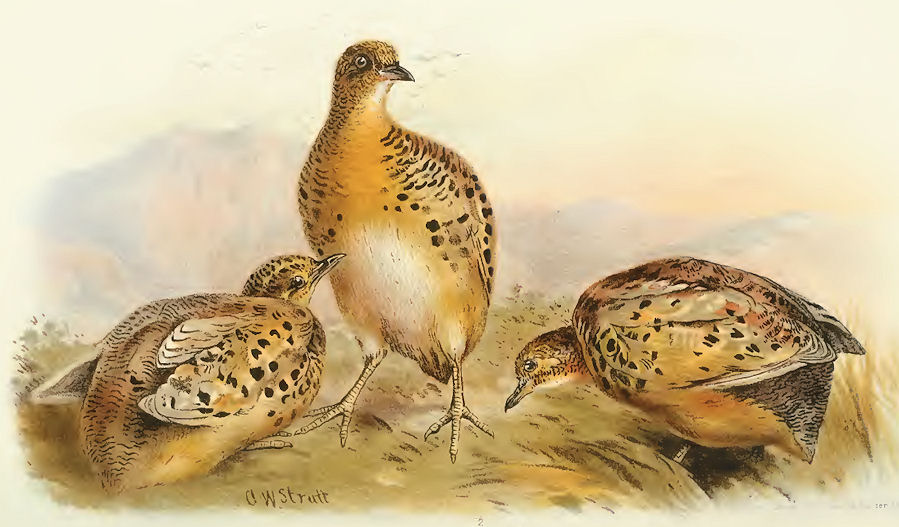
Abb.: लावाः । Turnix tanki Blyth, 1843 - Yellow legged Buttonquail -
Rotnacken-Laufhühnchen
[Bildquelle: Indian sporting birds. -- 1915.]
|
"Although more numerous in India proper than
the bustard-quail, and found in the North-west districts, where
the other is absent, the yellow-legged bird does not go
so high up in the Himalayas, my record of one caught by Mr.
Goldstein at Darjeeling, in my book on "The Game Birds of
India and Asia," being quite an exception, the usual limit of
this bird's vertical range being 4,000 feet. As this was caught at
night at light, it looks as if the bird were migrating, but
it might have been a mere stray. This button-quail does not
occur in Ceylon, and its eastern limit is the Naga Hills ; in
Assam begins the range of the large Burmese race of this
yellow-legged type.
There is little to be said about the habits
of this bird, which are much like those of the bustard-quail, but
it affects drier localities, and does not come quite so much
into cultivation on the whole ; moderately high grass is a pretty
good place in which to look for it, and it is also found in
grassy patches in forest clearings. Its flight is feebler and less
whirring and noisy than the bustard-quail's, and it goes for even a
shorter distance when flushed, dropping so quickly as scarcely to
allow time for a shot, and lying so close afterwards that smart dogs
may often pick it up. In captivity it shows an even tamer
disposition than the blue-legged bird. The first pair the Zoo
in London ever had, presented by Mr. E. W. Harper, were so
tame that I have poked my finger through and touched them as
they sat at the side of the aviary. This bird lays four eggs,
peppered and blotched like those of the bustard-quail, in
a domed nest of grass.
Mr. D. Seth Smith, now Bird Curator at the
Zoo, has given, in the Avicultural Magazine for 1902-03, some
very interesting details of the habits of this species as
observed by him in the private aviary he then had. He
successfully bred the birds, this being the first instance of any hemipode
being bred in Britain; and found out about the seasonal
change in the female's collar, and also that she gave any mealworms
given her to her mate, thus showing that the moral reversal of
the sexes in the hemipodes results in the hen being generous
as well as quarrelsome. She did not, however, feed the chicks, and
the male did everything for them as well as the sitting,
which only lasted twelve days—a remarkably short period, for
even a canary takes fourteen. In the aviary, which had a grassed
outdoor enclosure, he noticed that the birds did not seem so
much at home in the long grass itself as the painted quails,
which made little tunnels in it and bolted down them, but preferred
sandy spots with grass tufts here and there ; this is rather
at variance with Indian experience of it as a grass bird, but Tickell
says it is found, in Bengal at any rate, "in open, sandy, bushy
places." The young were mottled rather than distinctly
striped like the young of the true quails, and were very
insectivorous, refusing at first all kinds of artificial food, which the young
of the true game birds nevertheless eat readily. The note of
the hen is "a soft booming sound, which is more or less
ventriloquial " ; the male seldom calls, if at all, and all the bird
utters when flushed in the wild state is a faint low double chirp.
Tickell says this bird is most delicious eating, but Hume condemns
it ; probably both are right, the difference depending on food."
[Quelle: Finn, Frank <1868 - 1932> Indian sporting birds.
-- London, 1915. -- S. 270ff.]
|
Turnix sylvaticus Desfontaines, 1787 - Small Buttonquail -
Laufhühnchen
13 cm
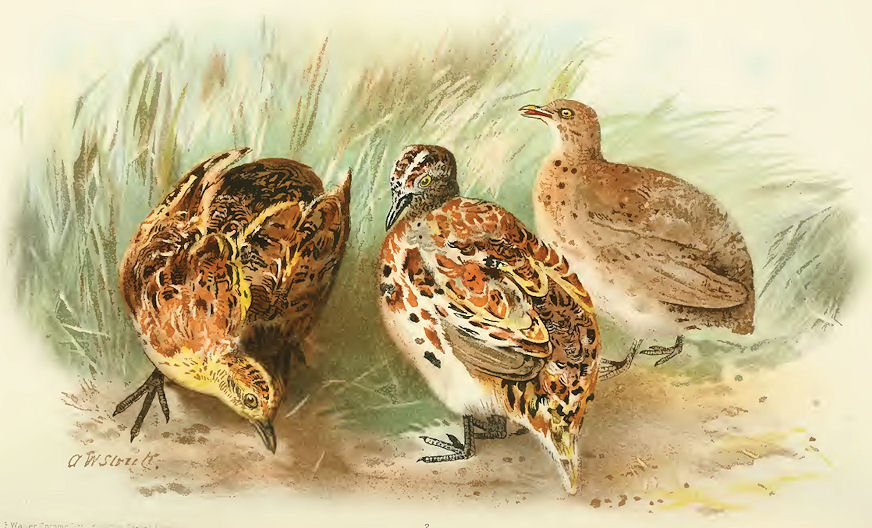
Abb.: लावाः । Turnix sylvaticus Desfontaines, 1787 - Small Buttonquail -
Laufhühnchen
[Bildquelle: Indian sporting birds. -- 1915.]
|
"The little button-quail, which, I take it, is
the button-quail, from the small size, is also the commonest of
our species where it occurs, and it has a wide range over the
Empire ; but it is not found at higher elevations than 6,000
feet, nor in Ceylon or the extreme south of India. To the drier
portions of the country it appears only to come in the monsoon. It
has the characteristic habits of hemipodes to perfection, sitting
particularly close in the low cover it affects, and when raised
taking an even shorter flight than the other species, so
that it can hardly be shot ; while after this effort it sits so
very tight that not only do dogs pick it up, but it has even been caught
by hand.
In disposition it is about the tamest bird in
existence ; in a cage it will let one pick it up like a white
mouse, and seems equally at home in close captivity, so that a
pair of these tiny beings would make interesting pets for any
one who likes birds, but can only find room for quite a small
portable cage. In England they have even been known to lay in a
cage, and at this time even threatened to charge the hand of
their owner ! What such tiny things could do against anything
bigger than a mouse or a locust is a problem, but evidently they
are not wanting in pluck. They have been found to feed on
grass-seed and white ants, and are to be seen in gardens as well
as in the open country. They are often found on land which
has been flooded during the rains. The nest, sometimes domed
and sometimes open, may be found even as late as October,
in some places, though breeding begins as early as April ;
the eggs tend to be more numerous than in the larger species, for
five and six may be found, though the usual hemipode clutch of
four is more general. They are of the pointed peg-top
shape, and show the typical dark peppering and spotting of the
family ; but are not so much smaller than those of the larger
button-quails, as would be expected—another point of resemblance to
the jack-snipe.
The note is described as a "plaintive moan"
or "a mixture of a purr and a coo," the bird when calling
raising its feathers and turning about like a courting pigeon. This
tiny bird is the smallest of our game birds, but, like the
tallest, the sarus crane, is rather a bird for the aviculturist than
the sportsman ; if one wants to eat small birds, larks would be more
worth shooting both for sport and for eating purposes.
Besides the name Dabki, which means " squatter," this little bird
rejoices in several others—Turra, Libbia and Chimnaj, in Hindustani ;
Telia dabbagundlu in Telugu, and Darwi at Ratnagiri. Yet we
are told that natives, unless professional bird-catchers,
generally consider it simply as a young quail of sorts, and
certainly it has all the appearance of a young bird which ought to
grow up into something quite different."
[Quelle: Finn, Frank <1868 - 1932> Indian sporting birds.
-- London, 1915. -- S. 273f.] |
Perdicula erythrorhyncha Sykes, 1832 - Painted Bush-quail
16 cm
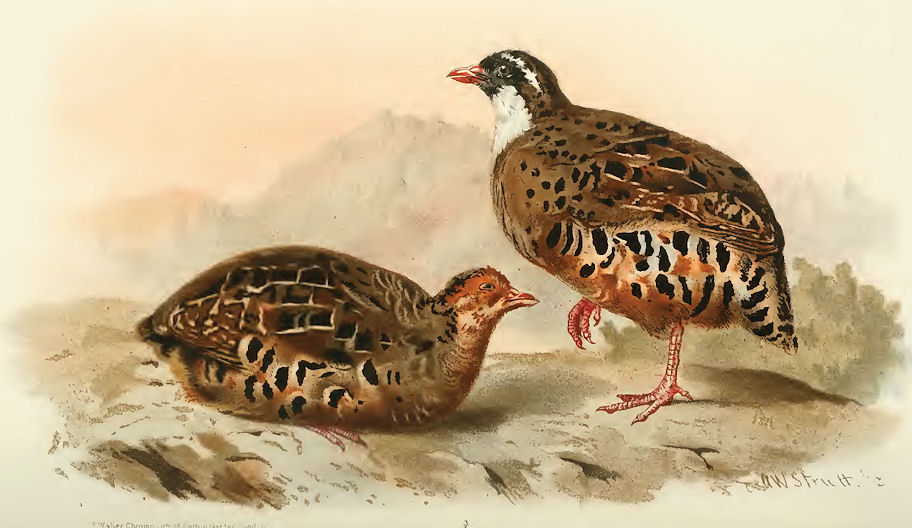
Abb.: लावौ । Perdicula erythrorhyncha Sykes, 1832 - Painted Bush-quail
[Bildquelle: Indian sporting birds. -- 1915.]
|
"Habitat. Southern India, from the Wynaad to
the Deccan in Poona. Has also been obtained in Coorg and on the
Neilgherries ; also at Karlee above the Khandalla Ghauts, and near Dharwar. Habits
the same as Bush Quails, living in small bevies. Breeds in the
Neilgherries from August to November. According to Mr. Mahon Daly, it is very
common amongst the coffee on the Shevaroys, and often in rocky ground with low
jungle. They go about nearly always in pairs, and not in large bevies as
stated by Jerdon. They lay from 6 to 8 eggs on the ground, with just a few
leaves placed around the nest. It is very daring. Mr. Daly adds that he has
seen it fly at a dog in defending its brood. January -to March, and again September
and October, are the months in which this species breeds. The eggs are long
ovals, pointed towards one end, rather glossy and spotless cafe au lait,
varying in length from 1.35 to 1.45 inches, and in breadth from 0.87 to 0.95."
[Quelle: Murray, James A.:
The avifauna of British India and its dependencies. -- London : Trübner,
1888-1890. -- 2 Bde. -- Bd. 2, S. 564.] |
|
"This very handsome Bush-quail has only been
found on the higher lands of Southern India, extending
along the crest of the Ghats, from the Wynaad to near Poonah, at all
events. I have observed it on the Neilgherries, in the
Wynaad, and in Coorg ; Col. Sykes recorded it from the valley of
Karleh, associating with Francolinus pictus, and Mr. W. Elliot
obtained it on the intervening ranges of Dharwar. It is far from rare in
Wynaad, and abundant on the Neilgherries, frequenting
bushy ground and patches of ferns on hill sides, or in the
valleys. It frequently enters gardens at Ootacamund, and may be
watched from the windows, running actively about, picking up
seeds and insects, and I have known many fall victims to the
stealthy pounce of some domestic Cat. It lives in moderately large
bevies, which rise all toogether, but with less whirr than the other
Bush-quails, their plumage generally being softer and not so firm."
[Quelle: Jerdon,
T. C. (Thomas Claverhill) <1811-1872>: The birds of India. --
Calcutta, 1862. -- Vol 2,2. -- S. 585.] |
Perdicula asiatica Latham, 1790 - Jungle Bush-quail -
Frankolin-Wachtel
17 cm
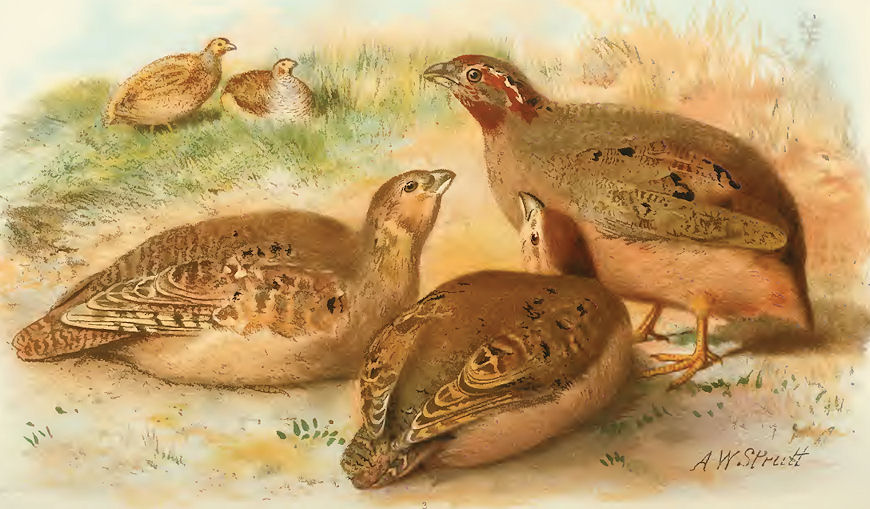
Abb.: लावाः । Perdicula asiatica Latham, 1790 - Jungle Bush-quail -
Frankolin-Wachtel
[Bildquelle: Indian sporting birds. -- 1915.]
|
"It is confined to our Empire, and in that to
the Peninsula and North Ceylon ; while even in this restricted
range it is local, although a dry or moist climate does not
affect it much ; nor is it particular about elevation, ranging up to
5,000 feet. But it wants its location dry underfoot, and frequents
wooded and broken or sloping ground, though it will come into
grass and stubble to feed, and is quite contented with scrub cover
; but cover of some sort it must have. Althongh a ground bird,
it will take to trees if put up by dogs, like the grey partridge,
and it also has the partridge habit of sociability carried to an
extreme, for, though sometimes found in pairs in the
breeding-season, it is usually found in coveys, even up to a score in
number, which pack very closely, and forage about together like a
flock of guinea-fowls in miniature.
This extreme sociability, which, as in the
great snow-cocks, extends so far that young ones may be seen in
company with several of their elders, makes it strange
that the birds should be so pugnacious, but probably the ties of
friendship only hold for the same covey, which are mostly, no doubt,
near relatives. Strangers are probably barred by flocking
birds as well as solitary ones ; and in the case of another well-known
social bird, the rat-bird or common babbler (Argya caudata), two flocks
working the same hedge have been seen to meet and fight
with such fury that they adjourned to the road to fight out the
matter in couples. Be that as it may, this bush-quail is
commonly captured by means of a decoy-bird in a cage set with
nooses, like the grey partridge ; for more sporting methods of
capture it is not of much use, despite a remarkably tame
disposition, for when pressed the whole covey explodes, as it were,
in all directions, whistling and whirring—including sometimes,
as Tickell says, a close shave of the sportsman's countenance—and
each member drops as suddenly as it rose after just
shaving the bushes in a very swift flight of a couple of dozen yards,
rapidly reassembling to the peculiar trilling pipe of the head of
the covey. When bagged bush-quail are not much to boast of,
weighing little over two ounces, and being very dry. They feed
chiefly on seeds of grass and millet, and are pretty certain to
be found in ragi stubble ; insects are also often consumed.
They breed very late in the year, beginning
in September, and eggs may be taken in February ; the nest
is under a tuft of grass or a bush, and fairly neatly made, and
the eggs pale creamy and as few as four or as many as seven in
number."
[Quelle: Finn, Frank <1868 - 1932> Indian sporting birds.
-- London, 1915. -- S. 253f.] |
Perdicula argoondah Sykes, 1832 - Rock Bush-quail
17 cm
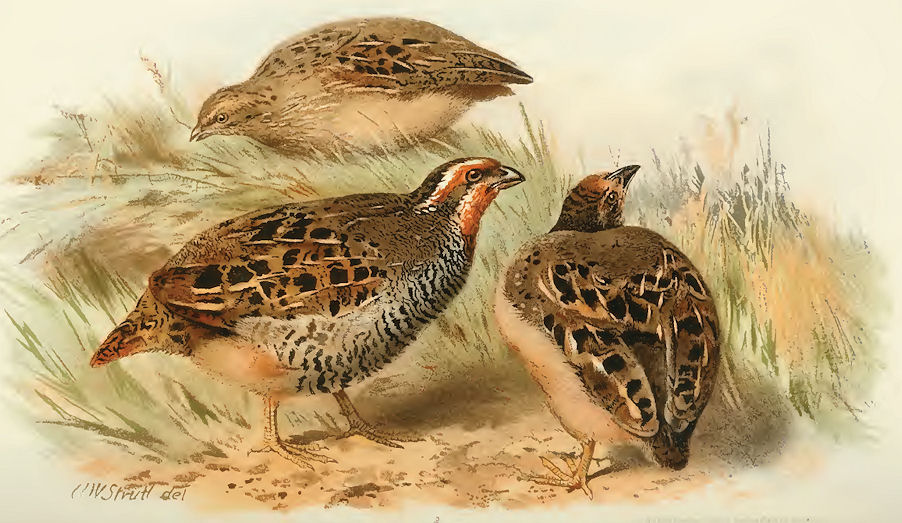
Abb.: लावाः । Perdicula argoondah Sykes, 1832 - Rock Bush-quail
[Bildquelle: Indian sporting birds. -- 1915.]
|
"The Rock Bush-quail is found over most of
Southern India, avoiding the Malabar Coast and forest
districts generally, as well as the more highly cultivated portions. It is
abundant in parts of the Carnatic and Mysore, as well as in the
more barren portion of the Deccan, but does not appear to occur in the
North of India at all beyond the Nerbudda, although very suitable
ground for it occurs both at Mhow and Saugor. It frequents rocky
hills with low scrub jungle, and especially barren
uncultivated plains, scantily covered with low bushes of Zizyphus or
Carissa and other thorny shrubs, out of which the bevy rises, ten or a
dozen or twenty together, with a startling suddenness and bustle,
dispersing more or less among the neighbouring bushes. The flesh of
this Bush-quail, as well as of the last, is perfectly white,
and it makes a good pie ; plain roasted they are not so good as the
species of Cuturnix, being dry and with little flavour.
The Lowa is much used for fighting among the
Mussulmans of Southern India, as indeed, the Geerza is
also, though not so common, nor so highly esteemed. Burgess found this
Bush-quail breeding from December to March, but found
only four pale buff eggs. It probably lays considerably more."
[Quelle: Jerdon,
T. C. (Thomas Claverhill) <1811-1872>: The birds of India. --
Calcutta, 1862. -- Vol 2,2. -- S. 584.] |
2.9.89. Polyplectron bicalcaratum - Grey Peacock-pheasant -
Grauer Pfaufasan
64/48 cm
|
35 a./b.
tittiriḥ kukkubho lāvo
jīvañjīvaś
cakorakaḥ तित्तिरिः कुक्कुभो लावो जीवञ्जीवश् चकोरकः ।३५ क।
जीवञ्जीव - jīvañjīva m.:
Jīvañjīva ("eher onomatopoetisch , als eine reduplizierte Form von जीव् oder
eine Zusammensetzung von जीव und जीव" PW) = "Polyplectron bicalcaratum Linnaeus,
1758 - Grey Peacock Pheasant." (Dave, 496) |
Colebrooke (1807): "Perhaps a pheasant."
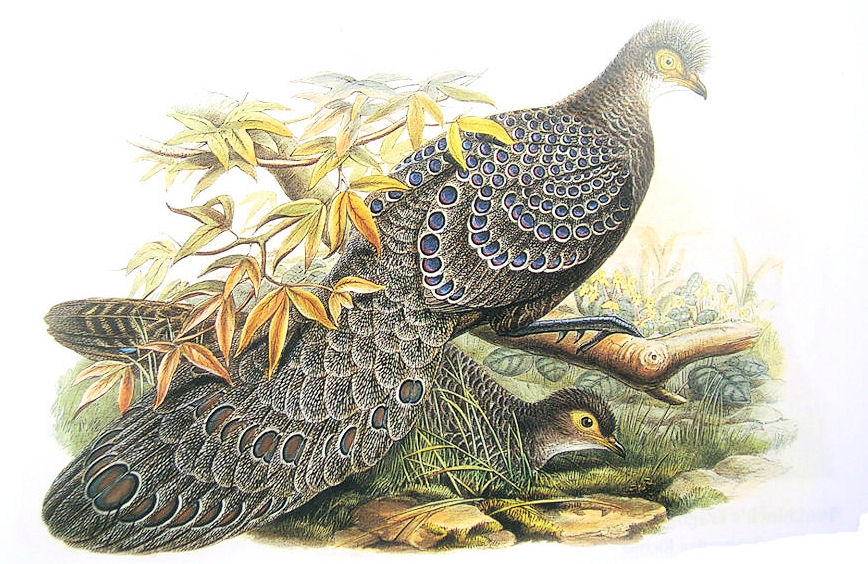
Abb.:
जीवञ्जीवौ । Polyplectron bicalcaratum - Grey Peacock-pheasant -
Grauer Pfaufasan
[Bildquelel: John Gould: A Century of Birds from the Himalayas (1830-32) /
Wikimedia. -- Public domain]
|
"In time of courtship his hairy-looking crest,
which is always longer than the hen's and is
chronically on end, turns right forward over his beak, even when he is
not otherwise displaying. No doubt he fights with his
rivals, and his legs are often armed with several spurs apiece, but
the number is very variable, and some time ago I noted in three
males at the Zoo, all imported birds and several years old,
that 'all differed in this point, one indeed having no spurs at all and
another only one. It looks, therefore, as if the idea current
among the Kookies, that a new spur grows every year, is
incorrect, and that the number of spurs is purely an individual
point. The morning and evening call of the cock, which begins
with the year, and is uttered at half-minute intervals, often for
an hour or more at a time, from a perch on a tree or stump, is
described as "something like a laugh" ; it certainly is in several syllables, but
the laugh is a very harsh one, and I have noted
it as a barking cackle. It is deceptive as to distance, and
yet furnishes the best means of stalking the bird, which is not at
all easy to get at by any sportsmanlike means. It keeps closely to
cover, especially bamboos and low trees ; only if it can be
forced to "tree" by hunting it with noisy curs, it may provide a
pot shot. Natives often snare it, and Davison once had a very
curious experience in getting specimens in this way in
Tenasserim, where he found the bird very common. "I found," he says, as
quoted by Hume, "three holes of the porcupine rat (of which
I got two specimens) communicating with one another ; the entrance
to one of these holes was nearly three feet in diameter and
some four feet in depth, decreasing, as the hole deepened
horizontally into the hill side, to about eight inches. I set a slip
noose with a springer in the small part of the holes. On looking next
morning, instead of, as I expected, finding the rat, there were
only a number of feathers of the male of this species. I set
the trap again, and that evening got nothing ; next morning I found a
hen hanging by her legs in the trap." Here were evidently a
pair in the habit of going to ground, a custom which needs
investigation. The birds, by the way, generally do pair, and
seldom more than four are seen together, such parties being
probably families, since in captivity only two eggs are laid at a time.
The birds begin breeding about May, retreating to the densest
jungles at this time, and ceasing to call till the autumn ;
the cream-coloured eggs, about two inches long, are laid on the
ground under a bush, and the young when hatched run close
behind their mother, completely hidden from view by her
long broad tail, which she expands to cover them. They are
dark chocolate in colour, without stripes, and their slim
black legs are noticeable and characteristic, the old birds being
particularly fine-limbed, and slaty-black in the colour of these parts.
This peacock-pheasant is excellent eating ;
it feeds on insects, snails, seeds, and especially on certain red
berries which are used by the Kookies as bait for their
springes. Fortunately, these catch more cocks than hens, but
poaching tricks of this sort ought to be made illegal everywhere ;
there are plenty of vermin that want killing down everywhere in
India, and the destructive energies of natives should be
directed on these rather than game-birds. The beautiful plumage
of this bird is very suitable for decoration, and if
protected during the breeding season it might well be made to supply this.
The tea-garden coolies recognize the affinity
of this bird to the peacock by calling it one Paisa-walla Majur. [...]
Outside our limits this bird is found in Siam."
[Quelle: Finn,
Frank <1868 - 1932> Indian sporting birds. -- London, 1915. --
S. 165f.] |
2.9.90. Alectoris chukar Gray, 1830 - Chukar Partrigde -
Chukarhuhn
38 cm
|
35 a./b.
tittiriḥ kukkubho lāvo jīvañjīvaś
cakorakaḥ तित्तिरिः कुक्कुभो लावो
जीवञ्जीवश् चकोरकः ।३५ क।
चकोरक
-
cakoraka m.: Cakoraka = "Alectoris chukar (Partrigde)." (Dave, 494) |
Colebrooke (1807): "Sort of partridge, (Perdix rufe, B.)"
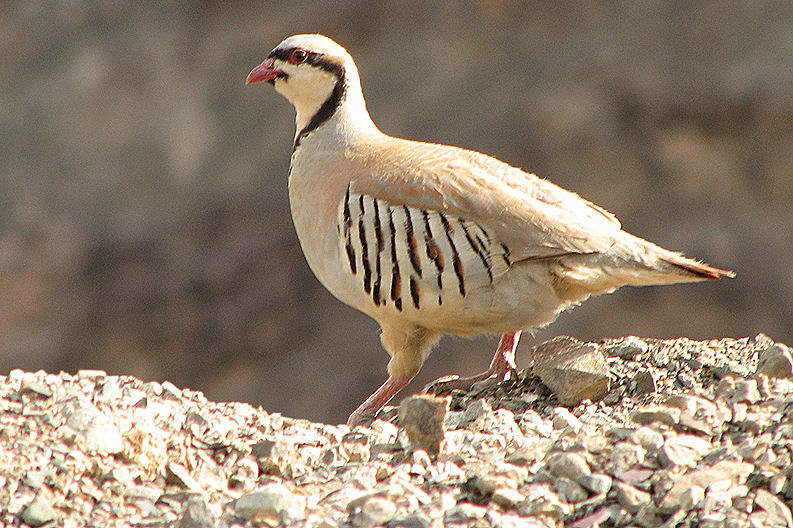
Abb.: चकोरकः । Alectoris chukar Gray, 1830 - Chukar Partrigde -
Chukarhuhn, Spituk, Ladakh
[Bildquelle: wildxplorer. --
http://www.flickr.com/photos/krayker/2580070994/. -- Zugriff
am 2010-12-25. --
Creative Commons Lizenz (Namensnennung)]
|
"Habitat. Throughout the Himalayas to Afghanistan.
Common also in Beloochistan, Sind, Punjab Salt Range, Persia
and along the Arabian Coast. Breeds from May to July in Chaman (S.
Afghanistan), making a nest composed of a little grass under the shelter of grass
tufts or bushes. The normal number of eggs is 12, but as many as 14 and 16 have
been taken from a single nest, all varying in size and shape, from peg-tops
to elongated ovals. The colour is also variable, but typically is a pale
cafe au lait ground colour, with brick-red specklings. The Chukor Partridge is very
pugnacious, especially during spring time, when two fighting cocks may be
almost knocked over with a stick. They are much prized for their
fighting propensities, and in Beloochistan and Afghanistan the men have a number trained
for the purpose, on which large bettings are made."
[Quelle: Murray, James A.:
The avifauna of British India and its dependencies. -- London : Trübner,
1888-1890. -- 2 Bde. -- Bd. 2, S. 553.] |
|
"The Chukor is found throughout the Western
Himalayas, from the lowest range to the Snows, and passing
over into Thibet, but it does not extend so far east as Sikim. It
is also met with in the salt range of the Punjab, and its more alpine
regions, passing into Afghanistan. It prefers bare and rocky hills
with low scrab or jungle, near cultivation. "In our part of the hills" says Mountaineer
(i. e. in the Northwestern Himalayas) "the Chuckore is most numerous in
the higher inhabited districts, but is found
scattered over all the lower and middle ranges. In summer they spread
themselves over the grassy hills to breed, and about the
middle of September begin to assemble in and around the
cultivated fields near the villages, gleaning at first in the grain
fields which have been reaped, and afterwards during winter in those
which have been sown with wheat and barley for the ensuing
season, preferring the wheat. A few straggling parties remain on
the hill sides where they breed, as also in summer many
remain to perform the business of incubation in the fields. In
autumn and winter they keep in loose scattered flocks, very
numerous, sometimes to the number of forty or fifty, and even a
hundred. In summer, though not entirely separated, they are
seldom in large flocks, and a single pair is often met with. They are
partial to dry stony spots, never go into forest, and in the
lower hills seem to prefer the grassy hill sides to the
cultivated fields. This may probably be owing to their comparatively
fewer numbers, as I have observed that many others of the
feathered race are much shyer and more suspicious of man when rare,
than those of the same species in places more numerous. Their
call is a kind of chuckling, often continued for some time and
by a great many birds at once. It is uttered indiscriminately
at various intervals of the day, but most generally towards
evening.
"The Chuckore feeds on grain, roots, seeds,
and berries ; when caught young, it becomes quite tame, and will
associate readily with domestic poultry.
"From the beginning of October, Chuchore
shooting, from the frequency and variety of the shots, and the
small amount of fatigue attending it, is to one partial to
such sport perhaps the most pleasant of any thing of the kind in the
hills. About some of the higher villages, ten or a dozen brace may
be bagged in a few hours. Dogs may be used or not at the
discretion of the Sportsman ; they are not at all necessary, and if at
all wild are more in the way than otherwise."
"The male," says Major Brown, "is very bold,
and is tamed for the purpose of fighting. In a
domesticated state, he makes no hesitation in offering battle to every
animal, and pecks very fiercely, always searching for a tender part
; the nose of a dog, or the naked feet of the native servants
immediately attract his attention, and he soon makes the object of
his attack fain to run."
"When reclaimed" says another writer in the
same periodical "this bird is peculiarly bold, fearless, and
entertaining. It trots about the house, and is as familiar as a
little dog. It is amusing to see its antipathy to quick motions in
others. It will follow a servant who hurries into a room, pecking at
his heels, scouring away when he attempts to turn upon it. It is
still more persevering against the poor wight who moves backwards
and forwards as he pulls the punkah. Half asleep at his
task, he is roused by a fierce attack on his legs. He
attempts to continue his work, and at the same time to drive away
the intruder, but it is of no use ; and he is at last obliged
to call for assistance to rid him of his persecutor."
The hen-chukor lays from eight to fifteen
eggs, of a creamy white, according to one writer ; pure white
according to Adams ; and the male bird is said to remain near the
nest during incubation, and may be heard calling all day, its call
much resembling that of the domestic hen, being a 'cuc-cuc often
repeated, and the Cashmeeres call it kau-kau from its cry. The
Afghans call it the Fire-eater. It is considered to be
excellent eating. In Ladak it is said to be numerous in the
cultivated part of the country, and is there called Nek-pa."
[Quelle: Jerdon,
T. C. (Thomas Claverhill) <1811-1872>: The birds of India. --
Calcutta, 1862. -- Vol 2,2. -- S. 565f.]
|
2.9.91. Vanellus indicus Boddaert, 1783 - Red-wattled
Lapwing - Rotlappen-Kiebitz
33 cm
|
35. c./d. koyaṣṭikaṣ
ṭiṭṭibhako vartako vartikādayaḥ
कोयष्टिकस् टिट्टिभको वर्तको वर्तिकादयः
॥३५ ख॥
कोयष्टिक
- koyaṣṭika m.: "Was für ein Stock [ist das]?" = "Red-wattled Lapwing." (Dave, 358)
= Vanellus indicus Boddaert, 1783 - Red-wattled
Lapwing - Rotlappen-Kiebitz |
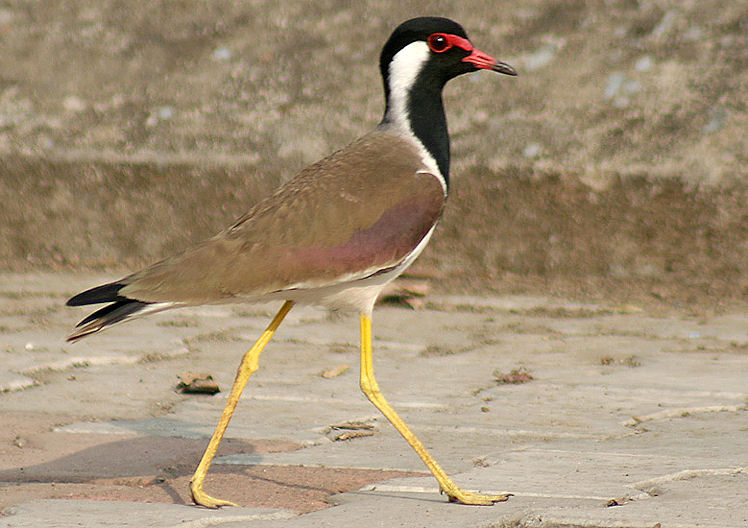
Abb.: कोयष्टिकः । Vanellus indicus Boddaert, 1783 - Red-wattled Lapwing -
Rotlappen-Kiebitz, Bhopal - भोपाल, Madhya Pradesh
[Bildquelle: J. M. Garg / Wikimedia. -- GNU FDLicense]

[Quelle der .ogg-Datei: Gypsypkd / Wikipedia. -- Public domain]
|
"Habitat. Throughout India, Beloochistan, Persia,
and Afghanistan. In India it is everywhere common, during both winter
and summer, and breeds from April to July. It is an extremely noisy
bird, and especially so during the breeding season. Its vulgar name, "Did he
do it," is very appropriately given, being its continuous cry, with "Pity to do it," the place resounding with its almost endless echoes, till the
intruder is out of reach of its nest. The nest is usually a small depression
in the earth, with or without lining of any kind, and made in the vicinity
of a marsh. The eggs are generally of a deep green colour, irregularly
marked with blotches and streaks of a brownish black."
[Quelle: Murray, James A.:
The avifauna of British India and its dependencies. -- London : Trübner,
1888-1890. -- 2 Bde. -- Bd. 2, S. 593.]
|
|
"This Lapwing is one of the best known birds
of India occurring everywhere, from Ceylon up to Cashmere. It is
replaced in Burmah by a closely allied race, L. atronuchalis, Blyth, in which the white ear patch does not extend
round the nape. It is generally found not far from water,
though now and then at some considerable distance : it is
occasionally seen in the cold season in scattered flocks, but
generally in pairs, or single. It feeds on various insects, shells,
and worms. It breeds from April to July, laying four large
eggs of a rich olive yellow colour with blotches of brown
and grey. Its wiles to allure a dog or man away from its eggs or
young are quite similar to those recorded of the English
Pee-wit, but its cries are still more vociferous. It is a noisy bird at
all times, and its cry has been variously rendered as, "Did he
do it. Pity to do it, Dick did you do it." In the South of India
it is recorded to sleep on its back with its legs upwards, and the
Indian proverb 'Titihri se asman thama jaega, &c.,' 'can the Pee-wit
support the Heavens,' is applied to a man who undertakes some task
far above his strength."
[Quelle: Jerdon,
T. C. (Thomas Claverhill) <1811-1872>: The birds of India. --
Calcutta, 1862. -- Vol 2,2. -- S. 648f.] |
2.9.92. Vanellus indicus Boddaert, 1783 - Red-wattled Lapwing -
Rotlappen-Kiebitz
& Vanellus malabaricus Boddaert, 1783 - Yellow-wattled Lapwing
- Gelblappen-Kiebitz
& Vanellus duvaucelii Lesson, 1826 - River Lapwing -
Flusskiebitz
|
35. c./d.
koyaṣṭikaṣ
ṭiṭṭibhako
vartako vartikādayaḥ कोयष्टिकस् टिट्टिभको वर्तको वर्तिकादयः ॥३५ ख॥
टिट्टिभक
- ṭiṭṭibhaka m.: Ṭiṭṭibhaka = "Vanellus indicus, Red-wattled Lapwing; Vanellus
malabaricus, Yellow-wattled Lapwing; Vanellus spinosus (V.
duvaucelii), Spurwinged Plover (River Lapwing)." (Dave 469) |
Colebrooke (1807): "Jacana, Tringa Goensis, (Parra Goensis,
&c.)."
Vanellus indicus Boddaert, 1783 - Red-wattled Lapwing -
Rotlappen-Kiebitz
33 cm
siehe zum Vorhergehenden
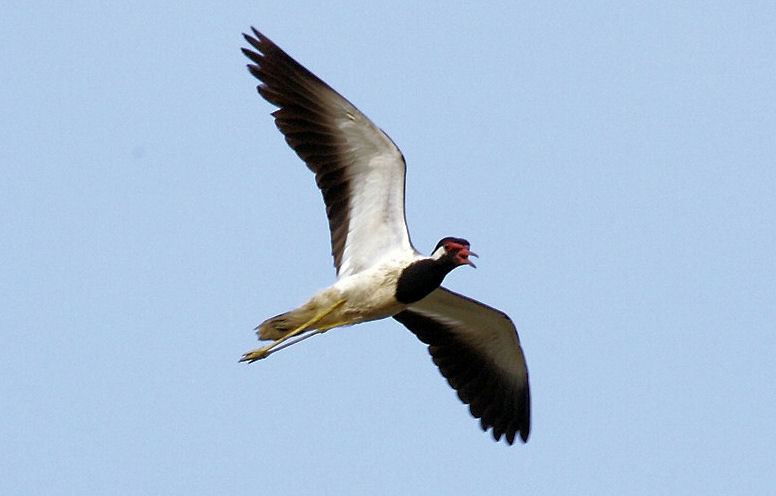
Abb.: टिट्टिभकः । Vanellus indicus Boddaert, 1783 - Red-wattled Lapwing -
Rotlappen-Kiebitz, Küste bei Chennai - சென்னை, Tamil Nadu
[Bildquelle: Lip Kee. --
http://www.flickr.com/photos/lipkee/503435014/. -- Zugriff am 2010-12-25. --
Creative Commons
Lizenz (Namensnennung, share alike)]
|
"Habitat. Throughout India, Beloochistan, Persia,
and Afghanistan. In India it is everywhere common, during both winter
and summer, and breeds from April to July. It is an extremely noisy
bird, and especially so during the breeding season. Its vulgar name, "Did he
do it," is very appropriately given, being its continuous cry, with "Pity to do it," the place resounding with its almost endless echoes, till the
intruder is out of reach of its nest. The nest is usually a small depression
in the earth, with or without lining of any kind, and made in the vicinity
of a marsh. The eggs are generally of a deep green colour, irregularly
marked with blotches and streaks of a brownish black."
[Quelle: Murray, James A.:
The avifauna of British India and its dependencies. -- London : Trübner,
1888-1890. -- 2 Bde. -- Bd. 2, S. 593.] |
|
"This Lapwing is one of the best known birds
of India occurring everywhere, from Ceylon up to Cashmere. It is
replaced in Burmah by a closely allied race, L. atronuchalis, Blyth, in which the white ear patch does not extend
round the nape. It is generally found not far from water,
though now and then at some considerable distance : it is
occasionally seen in the cold season in scattered flocks, but
generally in pairs, or single. It feeds on various insects, shells,
and worms. It breeds from April to July, laying four large
eggs of a rich olive yellow colour with blotches of brown
and grey. Its wiles to allure a dog or man away from its eggs or
young are quite similar to those recorded of the English
Pee-wit, but its cries are still more vociferous. It is a noisy bird at
all times, and its cry has been variously rendered as, "Did he
do if. Pity to do it, Dick did you do it." In the South of India
it is recorded to sleep on its back with its legs upwards, and the
Indian proverb 'Titihri se asman thama jaega, &c.,' 'can the Pee-wit
support the Heavens,' is applied to a man who undertakes some task
far above his strength."
[Quelle: Jerdon,
T. C. (Thomas Claverhill) <1811-1872>: The birds of India. --
Calcutta, 1862. -- Vol 2,2. -- S. 648.] |
Vanellus malabaricus Boddaert, 1783 - Yellow-wattled Lapwing -
Gelblappen-Kiebitz
27 cm
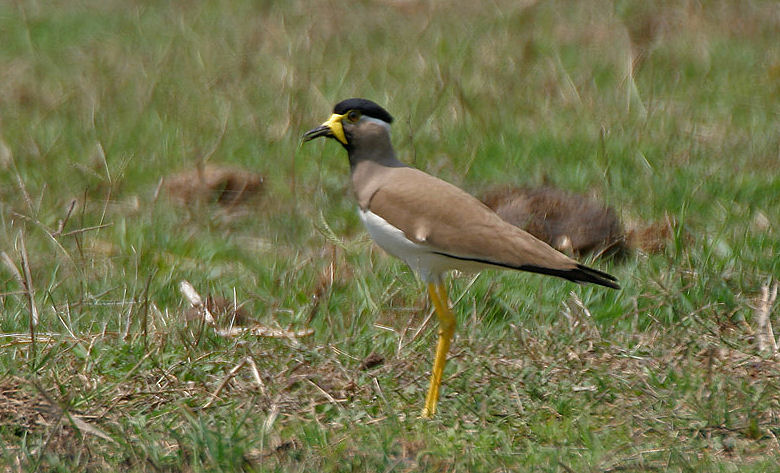
Abb.: टिट्टिभकः । Vanellus malabaricus Boddaert, 1783 - Yellow-wattled Lapwing
- Gelblappen-Kiebitz, Bharatpur - भरतपुर, Rajasthan
[Bildquelle: J. M. Garg / Wikimedia. -- GNU FDLicense]
|
"Habitat. Nearly throughout India, Burmah and
Ceylon. In India it is a resident, frequenting dry stony or grassy
plains usually in company with Cursorius isabellinus or gallicus. Breeds in
August on the edges of cultivated land. The eggs are not unlike those of L.
indicus, but are smaller, and have a stone colour ground, with deep brown and
nearly black blotches. In the winter plumage, the chin and throat and the
black edges to the feathers of the breast below are wanting, and the upper plumage is
duller or paler brown."
[Quelle: Murray, James A.:
The avifauna of British India and its dependencies. -- London : Trübner,
1888-1890. -- 2 Bde. -- Bd. 2, S. 594.] |
|
"The Yellow-wattled Plover is found throughout
the greater part of India, and also Ceylon ; is rare in
forest-clad and very rainy districts, abundant in the drier parts of the
country. It is rare in Bengal, but I have seen it in the Purneah
district, and it has been obtained occasionally near Calcutta. It
frequents dry stony plains, open sandy downs, and arable land,
often very far from water ; it associates in small flocks, except
at the pairing season, and feeds on various beetles, white ants,
worms, &c. It has a plaintive cry, much less harsh and loud than
that of the Red-wattled Lapwing, which Col. Sykes likens to Dee-wit,
Dee-wit. I have found the eggs, three to four in
number, of a reddish stone colour, spotted with brown and purplish,
on ploughed land and on sand banks."
[Quelle: Jerdon,
T. C. (Thomas Claverhill) <1811-1872>: The birds of India. --
Calcutta, 1862. -- Vol 2,2. -- S. 650.] |
Vanellus duvaucelii Lesson, 1826 - River Lapwing - Flusskiebitz
31 cm
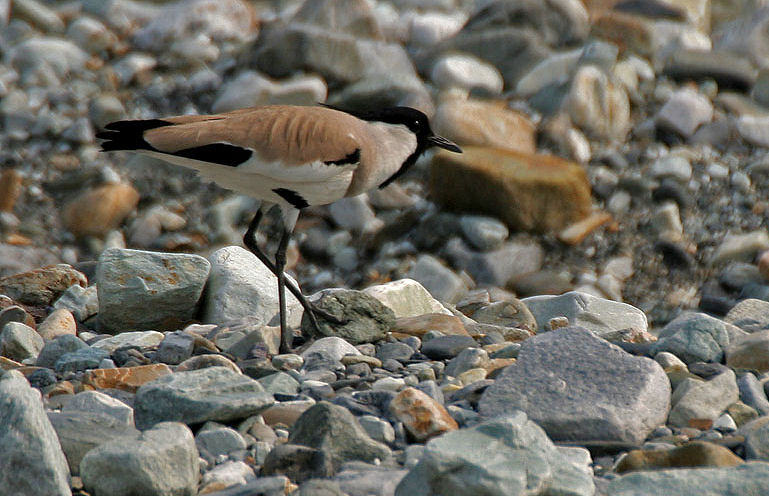
Abb.: टिट्टिभकः । Vanellus duvaucelii Lesson, 1826 - River Lapwing -
Flusskiebitz, Buxa Tiger Reserve - বক্সা জাতীয়
উদ্যান, West Bengal
[Bildquelle: J. M. Garg / Wikimedia. -- GNU FDLicense]
|
"Habitat. Northern India generally, Punjab, N.-W.
Provinces, Oudh, British Burmah, Bengal, and Central India, along the
sandy banks of rivers ; also in Pegu and Nepaul. It is rare in Sind. A single
specimen was got by Mr. W. Wallinger on the banks of the Indus near
Buggatora, who also mentions having seen it on the Aral near Sehwan.
Breeds on the banks and in the beds of most of the larger rivers of India
and Pegu, penetrating the hills to 2,OOO feet. March and April are the months in
which it lays. Eggs, four in number, from a stone to olivaceous drab
colour, profusely spotted with dark and purplish brown. In size they vary
from 1.42 to 1.78 in length, and in breadth from 1.12 to 1.3 inches."
[Quelle: Murray, James A.:
The avifauna of British India and its dependencies. -- London : Trübner,
1888-1890. -- 2 Bde. -- Bd. 2, S. 592.] |
|
"The Spur-winged Lapwing is found throughout
the greater part of India, but only along the course of
the larger rivers I have seen it on the Godavery, the Nerbudda,
the Ganges, and all its tributaries, for it appears more numerous
towards the North of India than in the South; I have not myself
seen it South of the Godavery, nor is it recorded by Col.
Sykes or Walter Elliot. It is usually found single or in
pairs, now and then in small flocks, but always in the sandy or
shingly beds of rivers, or not far from their banks. It is not rare
in mountain streams in the Himalayas, and I have shot it on the
banks of the great Runfreet River in Sikim.
Mr. Brooks, C. E., found the eggs of this
Lapwing on a sandy churr near Mirzapore ; they were of the usual
pale stone-green color, with blotches and spots of rich
chocolate brown, but varying somewhat both in shape, and in the
size and character of the spots."
[Quelle: Jerdon,
T. C. (Thomas Claverhill) <1811-1872>: The birds of India. --
Calcutta, 1862. -- Vol 2,2. -- S. 651.] |
2.9.93. Coturnix coturnix Linnaeus, 1758 - Common Quail - Wachtel
20 cm
|
35. c./d.
koyaṣṭikaṣ ṭiṭṭibhako
vartako
vartikādayaḥ कोयष्टिकस्
टिट्टिभको वर्तको वर्तिकादयः ॥३५
ख॥ वर्तक
- vartaka m.: Vartaka (zu vṛt 1 A: sich drehen, rollen) = "the largest Quail: Coturnix coturnix, Grey Quail (Common
Quail)." (Dave, 509) |
Colebrooke (1807): "A quail, and its female."
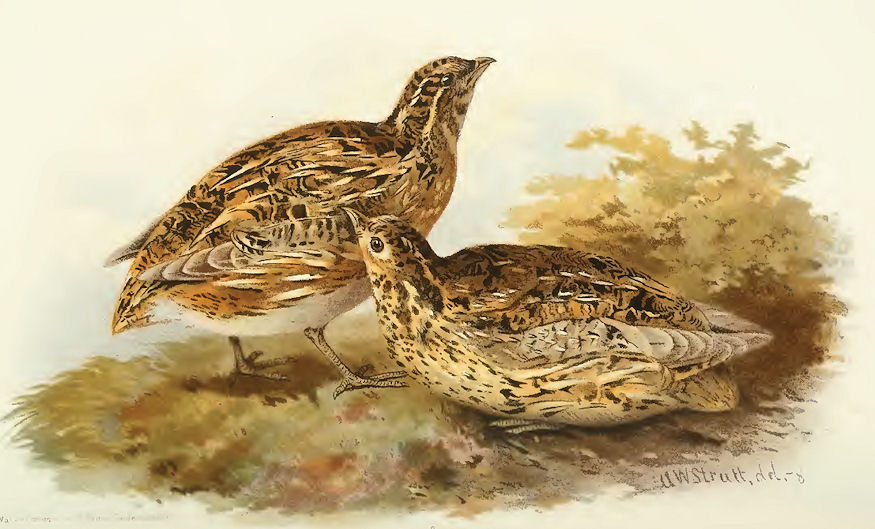
Abb.: वर्तकौ । Coturnix coturnix Linnaeus, 1758 - Common Quail - Wachtel
[Bildquelle: Indian sporting birds. -- 1915.]
|
"Habitat. Sind, Punjab, Beloochistan, Afghanistan,
Persia, Arabia, the Deccan, N. Guzerat, Rajputana, Kutch, Kattiawar and
Southern and Central India generally to Nepaul. A rare visitor to Burmah
and in the countries S.-E. of the mouths of the Ganges, Chittagong, Arracan
and Pegu, where it may be considered a straggler. It is found
throughout Europe and nearly the whole of Asia. The greater bulk of these which come
into India, Hume says, are migratory. They arrive from the North from
Central Asia across the Himalayas, and from the west from Persia,
Beloochistan, &c. Hume adds, that arrived within our boundaries, while a
certain number remain scattered about, some remaining in the lower ranges and
valleys of the Himalayas up to an elevation of 4000 to 5000 feet, the
greater bulk move forward, southwards and eastwards, and arrive about the middle of
October in Sylhet, Bengal, and the Deccan, and frequent the crops of peas,
millet, &c., to the end of March ; their stay, however, depends much on the
supply of food. They migrate invariably at night, and evidently in large
numbers at a time. Numbers are netted throughout India, for the table, for
quaileries, and the cock-birds for fighting purposes, a favourite pastime
nearly throughout India amongst Mahomedans. Breeds generally in the N.-W. and
Upper Provinces of India, laying six eggs, from February to April. Eggs
broad ovals, a good deal pointed towards one end. The ground colour is
a clear yellowish or reddish buff, thickly speckled and freckled and thinly blotched
with reddish brown."
[Quelle: Murray, James A.:
The avifauna of British India and its dependencies. -- London : Trübner,
1888-1890. -- 2 Bde. -- Bd. 2, S. 566.] |
|
"The European Quail is found throughout India,
in considerable numbers, during the cold weather, most
migrating during the rains, and breeding elsewhere, but a few pairs
remaining and breeding in various parts of the country, especially
towards the West and North-west. The Grey Quail, as it is
generally termed in India, generally rises singly or in pairs, but
considerable numbers are found together ; and, in some localities, and
in certain seasons, it occurs in great profusion, and affords
excellent sport to the gunner. It is found in long grass, corn-fields,
stubble and fields of pulse, wandering about according as the crops ripen
in different parts of the country. It is less numerous towards the
south of India than further north ; but in beating grass-lands
for the small Florikin, many are flushed. Dogs stand very steadily to
Quail, and in the cool weather excellent sport is to be had,
fifty couple being not unfrequently bagged by one gun in a mornings'
shooting in the North-western Provinces. In parts of Bengal,
they also abound much, and I have heard of seventy-five brace
being killed by two guns. I have received several authentic
notices of this Quail breeding in India, among other parts of the
country in Rajpootana and Bundelkund.
The female lays eight to twelve eggs, dull
whitish, blotched and speckled with umber brown. Gunga, in the
Bengal Sporting Magazine, says, that on one occasion, he
found four whitish eggs, dotted and blotched with pale red. The same
good observer states, with reference to the abundance or otherwise
of Quail, that 'if the country which lies between us and their
breeding country be defective from bad seasons, they proceed on,
and reach us in great numbers ; on the contrary, if they find food
nearer at hand, they stop.' Hodgson states that they reach
the valley of Nepal, in greatest numbers, at the ripening of the
autumn and spring crops, respectively. Quails are netted in
great numbers in some parts of the country, and many are also
caught in hair-nooses. The Nepalese have an ingenious way of
catching Quail. They put a pair of imitation horns on their heads,
and walk slowly about the stubble fields, twirling some blades of
grass in their hands in a way to imitate the champing of grass by
cattle, and as these birds are not alarmed by cattle, they succeed
in driving any quail they see under a small net, which they then
drop, and secure the bird."
[Quelle: Jerdon,
T. C. (Thomas Claverhill) <1811-1872>: The birds of India. --
Calcutta, 1862. -- Vol 2,2. -- S. 587f.] |
2.9.94. Coturnix coromandelica Gmelin, 1789 - Rain Quail - Regenwachtel
& Coturnix chinensis Linnaeus, 1766 - Blue-breasted Quail -
Zwergwachtel
|
35. c./d.
koyaṣṭikaṣ ṭiṭṭibhako vartako
vartikādayaḥ कोयष्टिकस्
टिट्टिभको वर्तको वर्तिकादयः ॥३५ ख॥
वर्तिका - vartikā f.: weibliche (= kleinere) Wachtel (vartaka) = "smaller Quails: Coturnix coromandelica, Black-breasted
Quail; any Quails." (Dave, 504)
und andere. |
D.h. vor allem:
- Coturnix coromandelica Gmelin, 1789 - Rain Quail - Regenwachtel
- Coturnix chinensis Linnaeus, 1766 - Blue-breasted Quail -
Zwergwachtel
Coturnix coromandelica Gmelin, 1789 - Rain Quail - Regenwachtel
18 cm
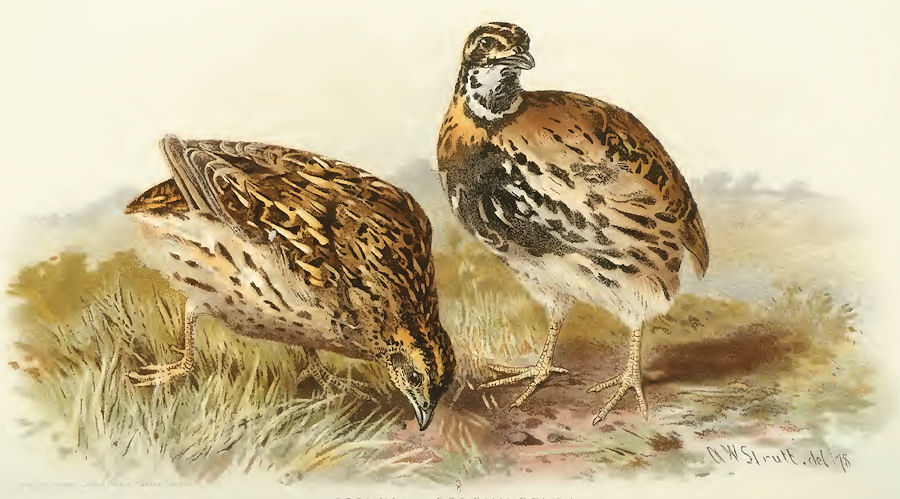
Abb.: वर्तिके । Coturnix coromandelica Gmelin, 1789 - Rain Quail - Regenwachtel
[Bildquelle: Indian sporting birds. -- 1915.]
|
"Habitat. Sind, Punjab, N.-W. Provinces, Oudh,
Bengal, Beloochistan, Persian Gulf, Rajputana, N. Guzerat, Kutch, Kattiawar,
the Concan, Deccan, Central and parts of South India, also Dacca and
Sylhet. Rain Quail visit India during the monsoon months, about the end of
July, and remain to breed. The majority breed in the Deccan, Guzerat,
Central India and parts of the Central Provinces. In Oudh, Behar and the
N.-W. Provinces, only a very limited number remain to breed. July to
October are the months in which they breed. The eggs are not unlike those of
C. communis. They leave about the end of October or middle of November."
[Quelle: Murray, James A.:
The avifauna of British India and its dependencies. -- London : Trübner,
1888-1890. -- 2 Bde. -- Bd. 2, S. 567.] |
|
"The Rain-quail, as it is called by many
Sportsmen, is found throughout the whole of India, rare in
thickly wooded or forest districts. In many parts of the country where
the grass is short and much dried up in the hot months, it is
not found, or at all events, it is rare till the rains have
commenced, and the young grass is springing up, when numbers appear all
over the country, entering gardens and grassy compounds, and
their pleasant whistle whit-whit, stronger in its tone than the
call of the Grey-quail, may be heard at all hours. On this account it has
received its popular name of 'Rain-quail.' Several writers in the
Bengal Sporting Magazine, including Hodgson, used to consider
the Coromandel and Rain-quail to be distinct; but the
well-known 'Gunga' shewed that they were the same bird, and that
the supposed distinction probably arose from Sportsmen
considering that Rain-quail, so called, were never met with, except during
the rains, whereas they are found at all seasons, but
attract attention less in the cold weather, and indeed are then often
confounded with the Grey-Quail.
Although it thus moves about, according to
the seasons, from one part of the country to another, it is not
strictly a migratory bird, and will occasionally be found in suitable
spots where there is grass or good cover, at all seasons. It is
frequently found in pairs, now and then in bevies, which however, do not
generally rise at once like the Bush-quail. Though not the special
object of the sportsman's attention, several of this Quail are
frequently shot, along with the large ones. Throughout considerable
part of Bengal, this bird does not appear to occur, or at all
events to be plentiful during the rains, and as it is the most moist
and grassy part of the country, probably many of the birds that
disperse over the country during the rains, find shelter and
food there in the hot weather. Both this and the Grey-quail are
very partial to the grains of Cheenee, a small Millet cultivated
extensively in Bengal during the hot weather and rains.
This Quail lays, from six to eight eggs
generally, of a creamy pink colour, with a few brownish spots, in a
tuft of grass, in June and July.
The Rain-quail extends to Assam, Sylhet, and
upper Burmah. I found it abundant at Thayet Myo, in May and June."
[Quelle: Jerdon,
T. C. (Thomas Claverhill) <1811-1872>: The birds of India. --
Calcutta, 1862. -- Vol 2,2. -- S. 589f.] |
Coturnix chinensis Linnaeus, 1766 - Blue-breasted Quail -
Zwergwachtel
14 cm
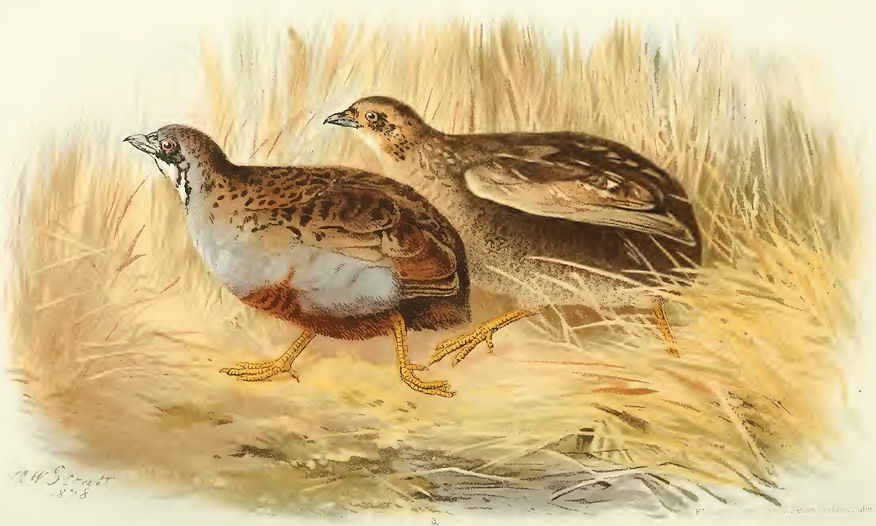
Abb.: वर्तिके । Coturnix chinensis Linnaeus, 1766 - Blue-breasted Quail -
Zwergwachtel
[Bildquelle: Indian sporting birds. -- 1915.]
|
"Habitat. Generally distributed over Eastern India
and Ceylon. Occurs in Bengal, Assam, Burmah, Southern and
Cochin-China, the Malay Peninsula, Sumatra, Java, and Borneo. In Ceylon it is
fairly common, especially towards the south of the island. In Burmah it is
generally distributed, but is nowhere common except in Pegu, where it arrives in
May in large numbers. In Raipur, Mandla, and the Chanda districts, also in the
Tributary Mahals, Singbhoom, Calcutta, Cachar, Sylhet, Khasia hills, as
well as in the Dafla hills and in the valley of Nepaul it is fairly common. It is
also recorded from Arracan. Open, swampy grassy lands or meadows are their
favourite haunts, and they are seldom found far from such spots. They do not
appear shy but freely come into the open to feed. Breeds in Pegu, Cachar,
Purneah, and the Sub-Himalayan districts from Sikkim to Kasauli.
Lays from June to the 1st or 2nd week in September. Eggs, 5 - 6, broad ovals,
of the shape of those of the Common Black Partridge, cafe au lait
tinged with olive in colour. In size they vary from 0.95 to 1.04 in length and from 0.7
to 0.81 in width."
[Quelle: Murray, James A.:
The avifauna of British India and its dependencies. -- London : Trübner,
1888-1890. -- 2 Bde. -- Bd. 2, S. 568.] |
|
"This beautiful little Quail recalls the
coloring of some of the American Quails, Ortyginae, the grey and
maronne tints being similarly present in one or more of that
group. The upper plumage, however, is that of typical Coturnix.
It is found in many parts of India ; but generally rare,
except in Bengal and adjacent provinces, and is still more
common in Assam and Burmah, where it is very abundant. Thence
it extends through the islands to Australia, and it is
said to be common in China and the Philippines. I have killed it
once only in the Carnatic ; one specimen is recorded in my Catalogue
from Belgaum in Western India. It occurs occasionally in
Central India, and in the Upper Provinces as far as Bareilly, but it is
rare in all these localities, and perhaps only stragglers find
their way so far. In lower Bengal it is tolerably abundant in damp
grassy meadows, the edges of Indigo fields, and in the grass
on road sides ; and in Purneah, in the month of July, it was the
only Quail I observed. It breeds in this month, the eggs being pale
olive-green. When the young are full grown, they disperse all
over the country, and this dispersion is greatly assisted, and in
many parts, perhaps, caused by the heavy inundations to which
great part of the country in Bengal is annually subjected,
generally in August or September ; and in the cold season they are
replaced by the Grey-quail, and the so called Rain-quail. "
[Quelle: Jerdon,
T. C. (Thomas Claverhill) <1811-1872>: The birds of India. --
Calcutta, 1862. -- Vol 2,2. -- S. 591f.] |
2.9.95. Vogelflügel / Schwinge - Wing
|
36. a./b. garut-pakṣa-cchadāḥ patraṃ patatraṃ ca tanūruham
गरुत्-पक्ष-च्छदाः पत्रं पतत्रं च तनूरुहम् ।२६ क।
[Bezeichnungen für Vogelflügel / Schwinge:]
-
गरुत् - garut m.:
Flügel
- पक्ष - pakṣa m.:
Flügel, Feder, Seite, Hälfte
- छद - chada m.: Decke,
Hülle, Flügel
- पत्र - patra n.:
Fluginstrument, Flügel, Feder, Blatt, Brief
- पतत्र -
patatra n.: Fluinstrument, Flügel, Feder
- तनूरुह - tanūruha
n.: "den Körper Besteigendes", Sohn, Körperhaar; "Aufsteigen des Körpers",
Flügel
|
Colebrooke (1807): "A wing."
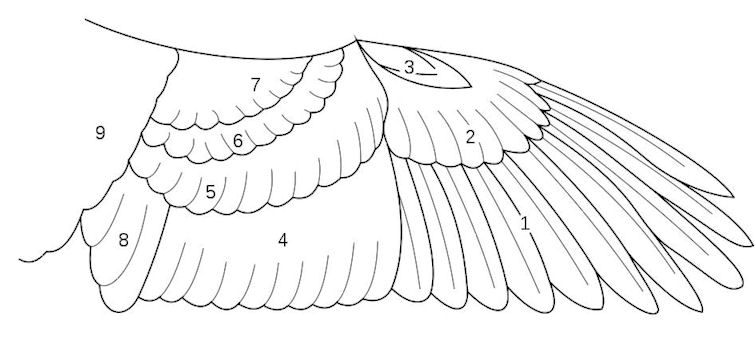
Abb.: गरुत् । Vogelschwinge: 1. Handschwingen, 2. Handdecken, 3. Daumenfittich,
4. Armschwingen, 5. Große Armdecken, 6. Mittlere Armdecken, 7. Kleine
Armdecken, 8. Schirmfedern, 9. Schulterfedern
[Bildquelle: Muriel Gottrop / Wikipedia. -- Public domain]
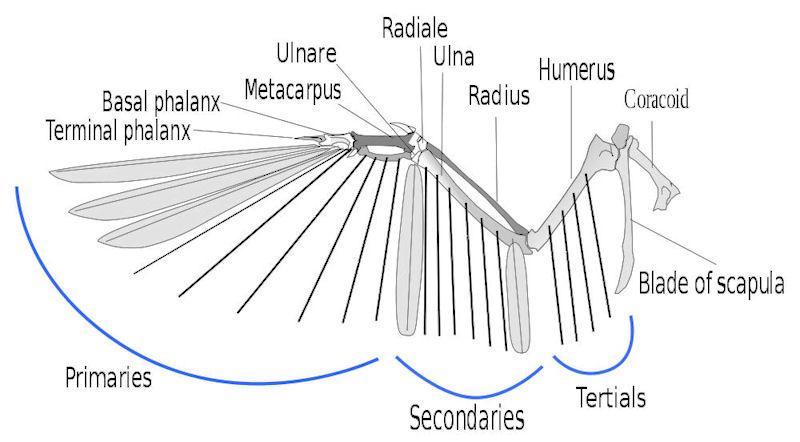
Abb.: पक्षः । Ansatzpunkte der Federn am Vogelarm
[Bildquelle: L. Shyamal / Wikipedia. --
Creative Commons
Lizenz (Namensnennung, share alike)]
2.9.96. Ansatzstelle des Flügels (Schulter) - Wing's root
|
36. c./d. strī pakṣatiḥ pakṣamūlaṃ
cañcus troṭir ubhe striyau स्त्री पक्षतिः
पक्षमूलं चञ्चुस् त्रोटिर् उभे स्त्रियौ ॥३६ ख॥
[Die
Ansatzstelle des Flügels (Schulter) heißt:]
- पक्षति
- pakṣati f.: Ansatzstelle des Flügels (zu pakṣa m.: Flügel)
- पक्षमूल
- pakṣamūla n.: Flügel-Wurzel
|
Colebrooke (1807): "Its root."
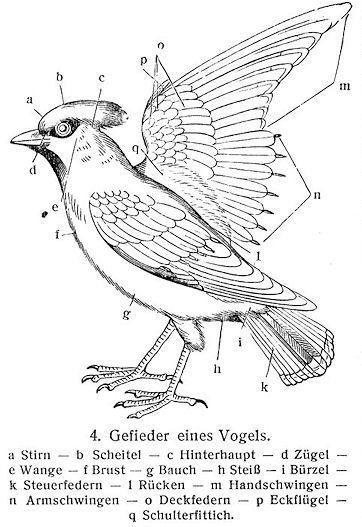
Abb.: Gefieder eines Vogels (q = पक्षतिः)
[Bildquelle: Meyers großes Konversations-Lexikon. --
DVD-ROM-Ausg. Faksimile und Volltext der 6. Aufl. 1905-1909. --
Berlin : Directmedia Publ. --2003. -- 1
DVD-ROM. -- (Digitale Bibliothek ; 100). -- ISBN 3-89853-200-3. -- s.v. "Vögel"]
2.9.97. Vogelschnabel - Beak
|
36. c./d.
strī pakṣatiḥ pakṣamūlaṃ
cañcus troṭir ubhe striyau स्त्री पक्षतिः पक्षमूलं चञ्चुस् त्रोटिर् उभे
स्त्रियौ ॥३६ ख॥
[Bezeichnungen für Vogelschnabel:]
- चञ्चु - cañcu
f.: Schnabel (zu cañc 1: hüpfen, springen; bezieht sich wohl auf die
hüpfende Schnabelbewegung beim Picken von Futter)
- त्रोटि
- troṭi f.: Schnabel
|
Colebrooke (1807): "The beak."
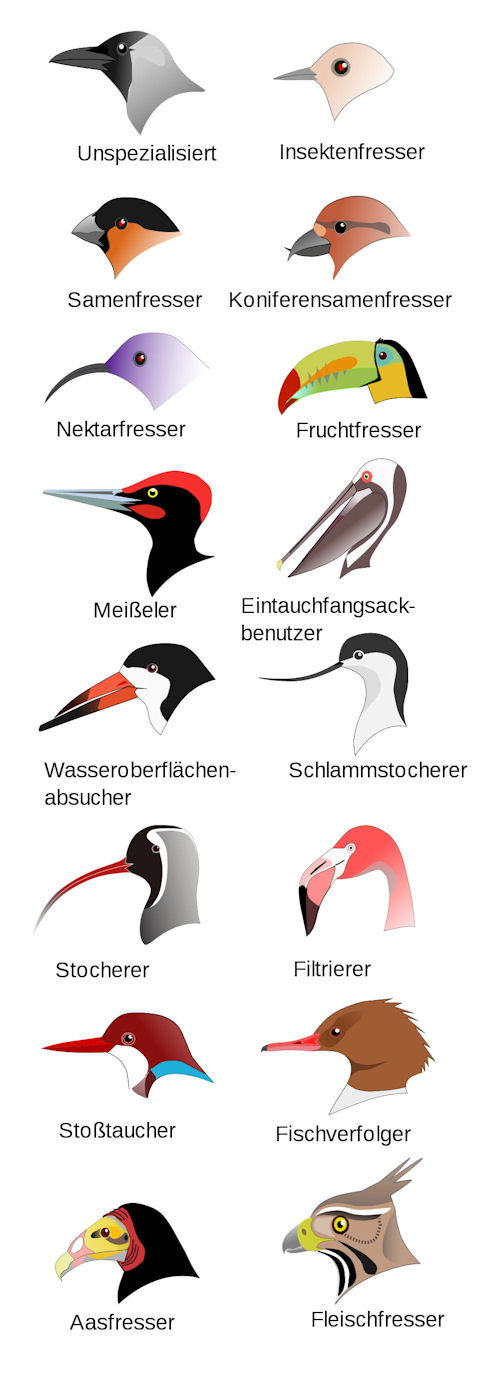
Abb.: चञ्चवः । Schnabelformen von Vögel
[Bildquelle: L. Shyamal / Wikipedia. --
Creative Commons
Lizenz (Namensnennung, share alike)]
2.9.98. Flugtechniken - Acts of flying
|
37. a./b. praḍīnoḍḍīna-saṃḍīnāny etāḥ khagagatikriyāḥ
प्रडीनोड्डीन-संडीनान्य् एताः खगगतिक्रियाः ।३७ क।
Die Techniken des Fliegens sind:
- प्रडीन - praḍīna n.: Vorwärtsfliegen
- उड्डीन - uḍḍīna n.: Aufliegen
- संडीन - saṃḍīna n.: Zusammenfliegen
|
Colebrooke (1807): "Acts of flying.
Severally mentioned : viz. taking flight, soaring, and perching ; or otherwise
interpreted, whirling, ascending, and alighting."
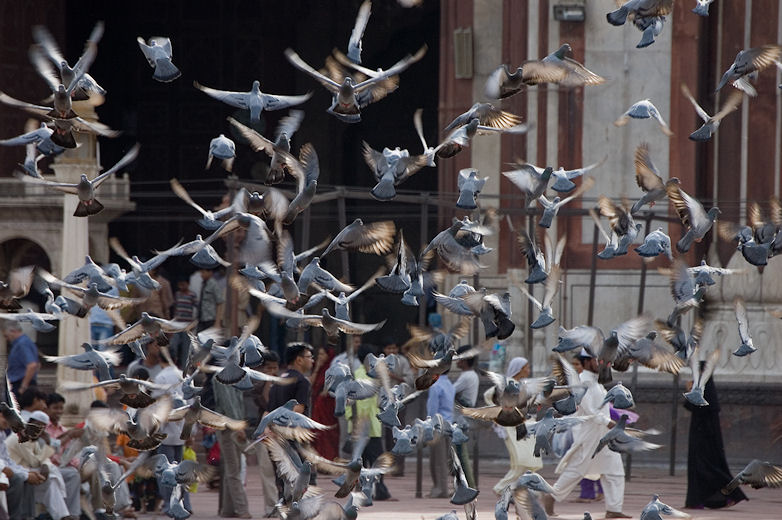
Abb.: उड्डीनम् । Tauben, Jama Masjid - مسجد جھان نما, Delhi
[Bildquelle:
Dan Kit. --
http://www.flickr.com/photos/dankit/138069962/. -- Zugriff am
2010-12-26. --
Creative
Commons Lizenz (Namensnennung, keine kommerzielle Nutzung, keine
Bearbeitung)]
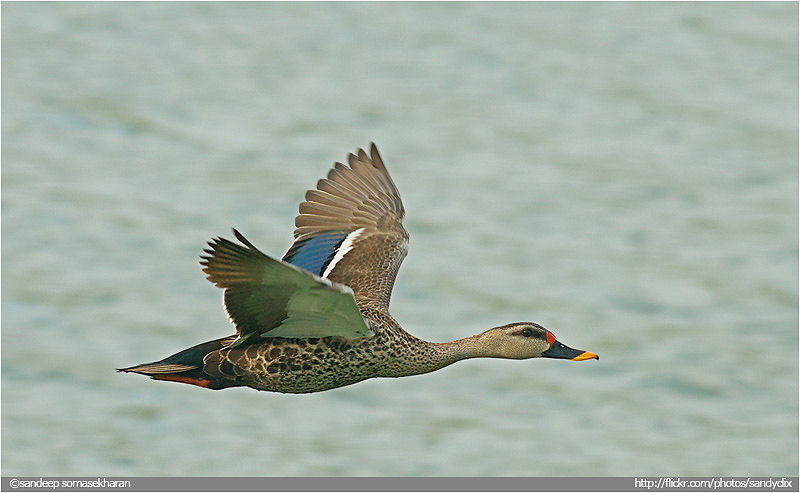
Abb.: प्रडीनम् । Anas poecilorhyncha J. R. Forster, 1781 - Indian
Spot-billed Duck - Fleckschnabelente, Mysore -
ಮೈಸೂರು, Karnataka
[Bildquelle:
Sandeep
Somasekharan. --
http://www.flickr.com/photos/sandyclix/4741044342/. -- Zugriff am
2010-12-26. --
Creative
Commons Lizenz (Namensnennung, keine kommerzielle Nutzung, keine
Bearbeitung)]
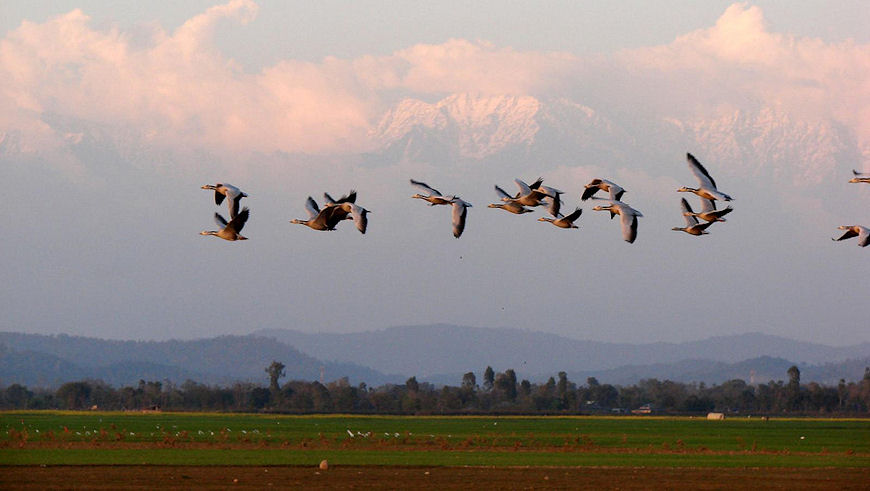
Abb.: संडीनम् । Anser indicus Latham, 1790 - Bar-headed Goose -
Streifengans, Maharana Pratap Sagar - महाराणा
प्रताप सागर, Himachal Pradesh
[Bildquelle:
Sankara
Subramanian. --
http://www.flickr.com/photos/sankaracs/3517591019/. -- Zugriff am
2010-12-26. --
Creative
Commons Lizenz (Namensnennung, keine kommerziell Nutzung, keine
Bearbeitung)]
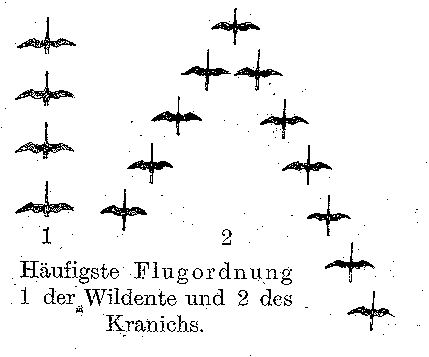
Abb.: संडीनम् । Häufigste
Flugordnung der Wildente (1) und des Kranichs (2)
[Bildquelle: Schmeil: Zoologie, 1919]
2.9.99. Vogeleier - Bird's eggs
|
37. c./d. peśī kośo dvihīne 'ṇḍaṃ kulāyo nīḍam astriyām
पेशी कोशो द्विहीने ऽण्डं
कुलायो नीडम् अस्त्रियाम् ॥३७ ख॥
[Bezeichnungen für Vogelei / Ei:]
-
पेशी - peśī f.:
Fleischstück, Muskel, Vogelei (zu peśa m.: Fötus)
- कोश - kośa m. n.:
Behälter
-
पेशीकोश -
peśīkośa m. n.: Behälter des Fleischstücks
- अण्ड - aṇḍa n.: Ei, Hoden
("Eier")
|
Colebrooke (1807): "An egg."
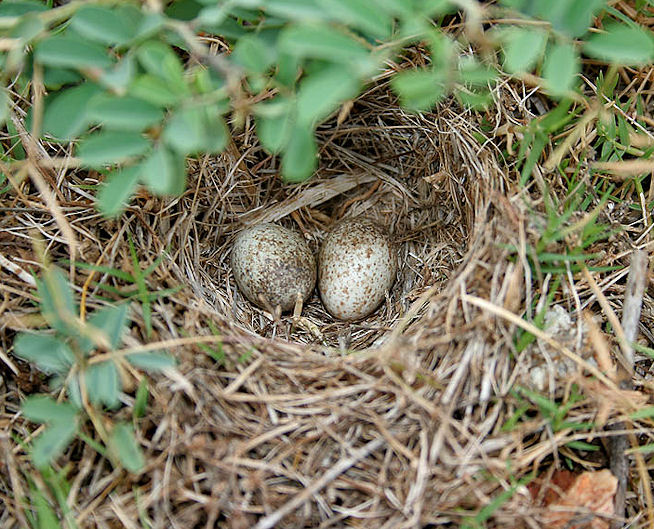
Abb.: अण्डे । Nest mit Eiern von Eremopterix griseus Scopoli, 1786 -
Ashy-crowned Finch-lark, Hyderabad -
హైదరాబాదు, Andhra Pradesh
[Bildquelle: J. M. Garg / Wikimedia. -- GNU FDLicense]

Abb.: अण्डानि । Nest mit Eiern von Corvus splendens Vieillot, 1817 - House Crow
- Glanzkrähe, Kolkata - কলকাতা,
West Bengal
[Bildquelle: J. M. Garg / Wikimedia. -- GNU FDLicense]
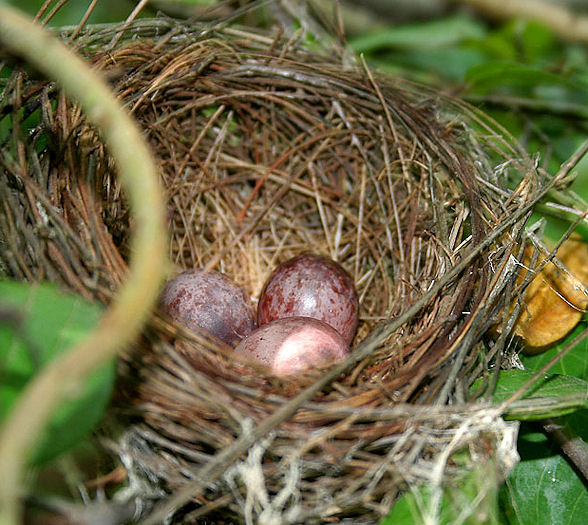
Abb.: अण्डानि । Nest mit Eiern von Pycnonotus cafer Linnaeus, 1766 - Red-vented
Bulbul - Rußbülbül, Ananthagiri Hills, Rangareddy District -
రంగా రెడ్డి జిల్లా, Andhra Pradesh
[Bildquelle: J. M. Garg / Wikimedia. -- GNU FDLicense]
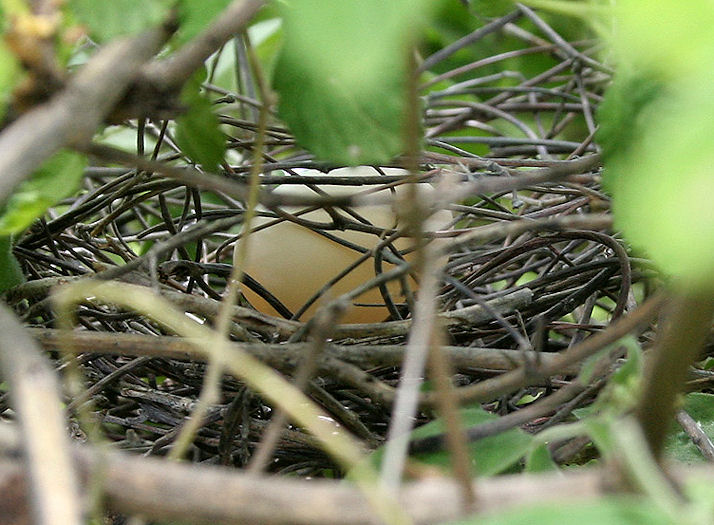
Abb. अण्डम् । Nest mit Ei von Streptopelia chinensis Scopoli, 1768 - Spotted
Dove - Perlhalstaube, Pocharam Lake, Andhra Pradesh
[Bildquelle: J. M. Garg / Wikimedia. -- GNU FDLicense]
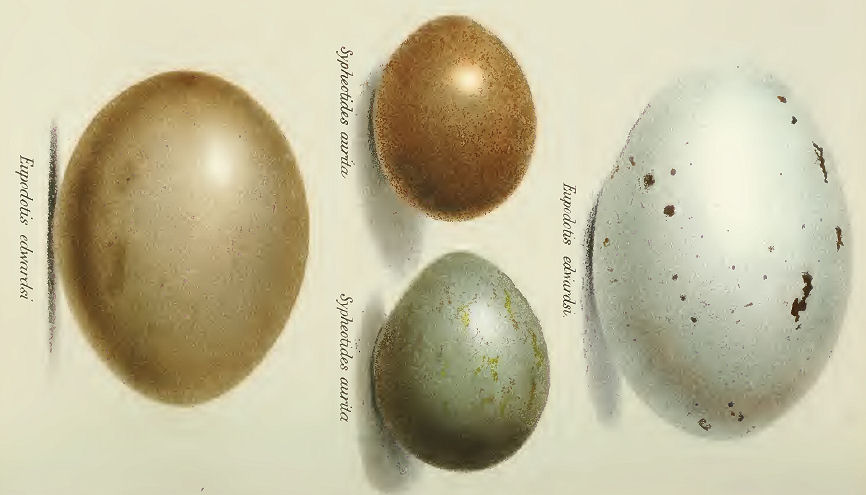
Abb.: अण्डानि । Eier einiger in Indien brütender Vögel
[Bildquelle: Indian sporting birds. -- 1915.]
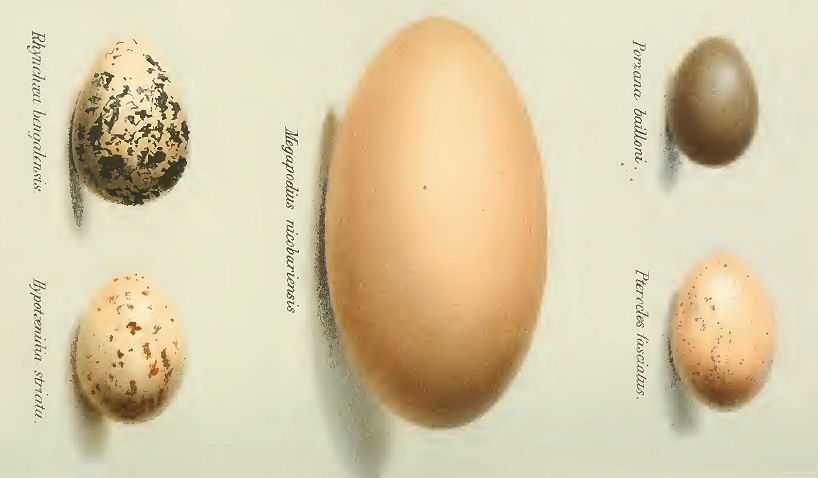
Abb.: अण्डानि । Eier einiger in Indien brütender Vögel
[Bildquelle: Indian sporting birds. -- 1915.]
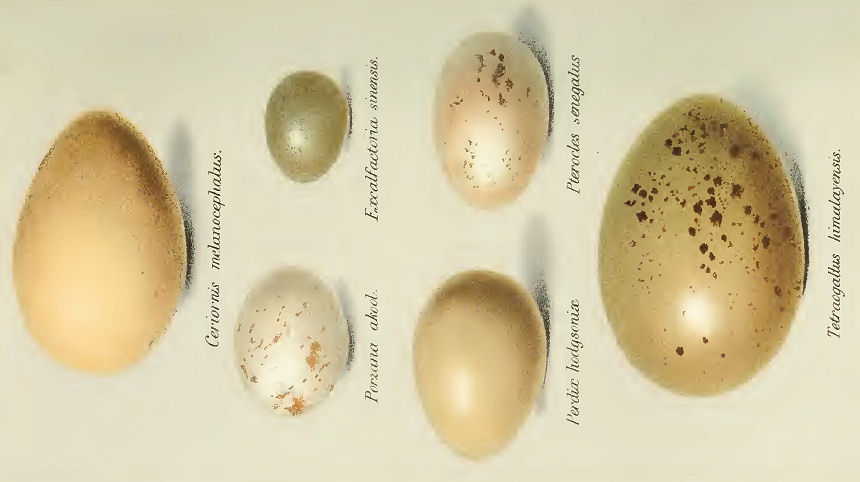
Abb.: अण्डानि । Eier einiger in Indien brütender Vögel
[Bildquelle: Indian sporting birds. -- 1915.]
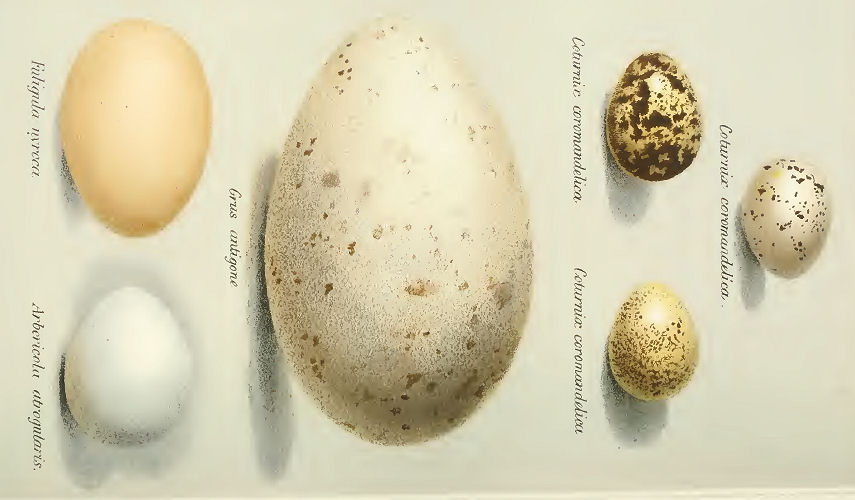
Abb.: अण्डानि । Eier einiger in Indien brütender Vögel
[Bildquelle: Indian sporting birds. -- 1915.]
2.9.100. Vogelnest - Nest
|
37. c./d.
peśī kośo dvihīne 'ṇḍaṃ
kulāyo nīḍam astriyām
पेशी कोशो द्विहीने ऽण्डं
कुलायो नीडम् अस्त्रियाम् ॥३७ ख॥
[Bezeichnungen für Vogelnest:]
-
कुलाय - kulāya m.: Geflecht, Nest, Lagerstatt (zu
kula n.: Familie)
-
नीड - nīḍa n. m.: Ruheplatz, Lager, Nest
|
Colebrooke (1807): "A nest."
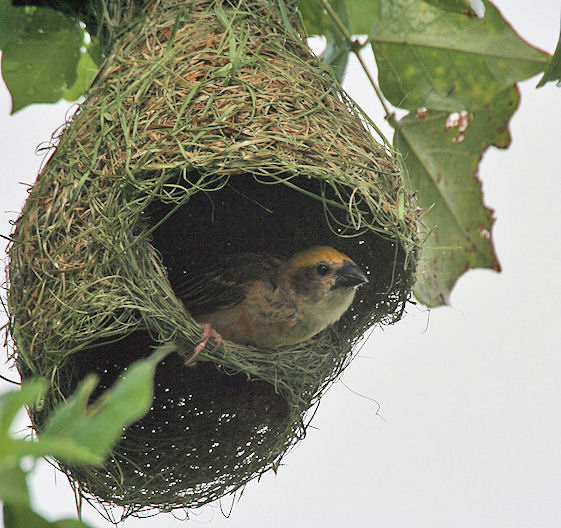
Abb.: नीडम् । Nest von Ploceus philippinus Linnaeus, 1766 - Baya Weaver -
Bajaweber, Kolkata - কলকাতা,
West Bengal
[Bildquelle: J. M. Garg / Wikimedia. -- GNU FDLicense]
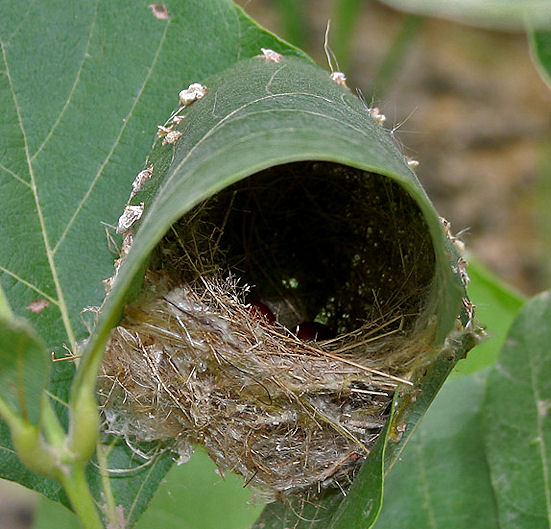
Abb.:
कुलायः । Nest von Orthotomus sutorius Pennant, 1789 - Common
Tailorbird - Rotstirn-Schneidervogel, Hyderabad -
హైదరాబాదు, Andhra Pradesh
[Bildquelle: J. M. Garg / Wikimedia. -- GNU FDLicense]
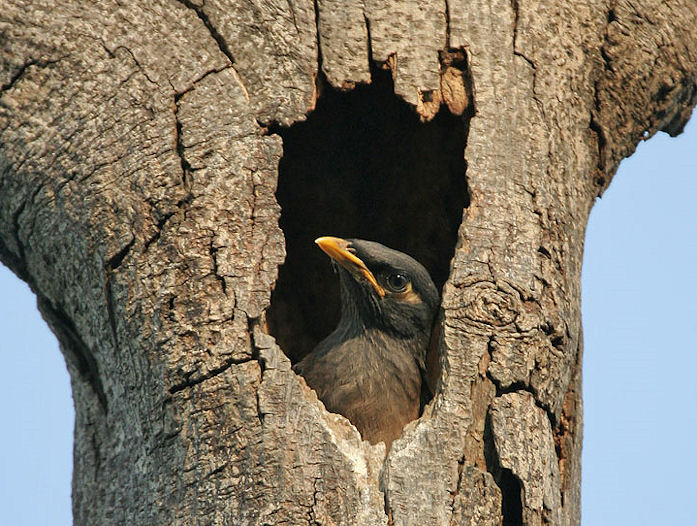
Abb.: नीडम् । Nest von Acridotheres tristis Linnaeus, 1766 - Common Myna -
Hirtenmaina, Kolkata - কলকাতা,
West Bengal
[Bildquelle: J. M. Garg / Wikimedia. -- GNU FDLicense]
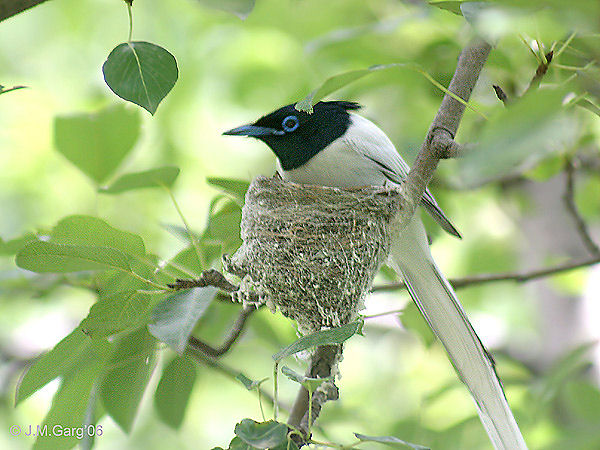
Abb.:
कुलायः । Nest von Terpsiphone paradisi Linnaeus, 1758 - Asian Paradise
Flycatcher - Asiatischer Paradiesschnäpper, Kullu District - कुल्लू, Himachal
Pradesh
[Bildquelle: J. M. Garg / Wikimedia. -- GNU FDLicense]
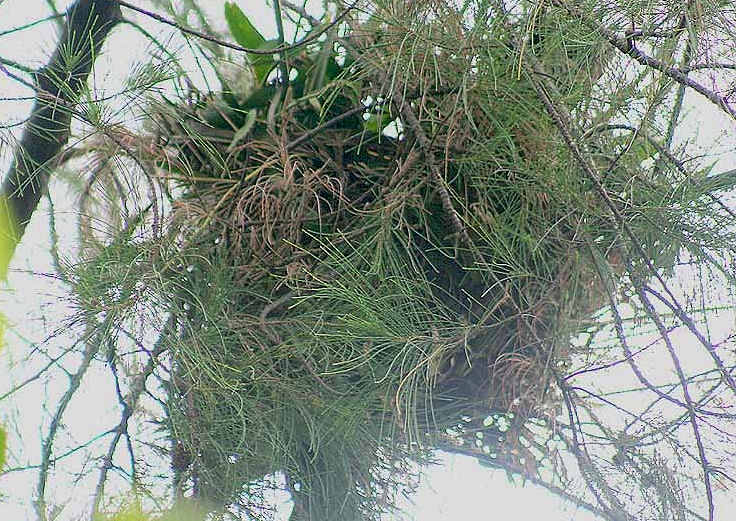
Abb.: नीडम् । Nest von Centropus sinensis Stephens, 1815 - Greater Coucal -
Chinesischer Spornkuckuck, Kolkata -
কলকাতা, West Bengal
[Bildquelle: J. M. Garg / Wikimedia. -- GNU FDLicense]
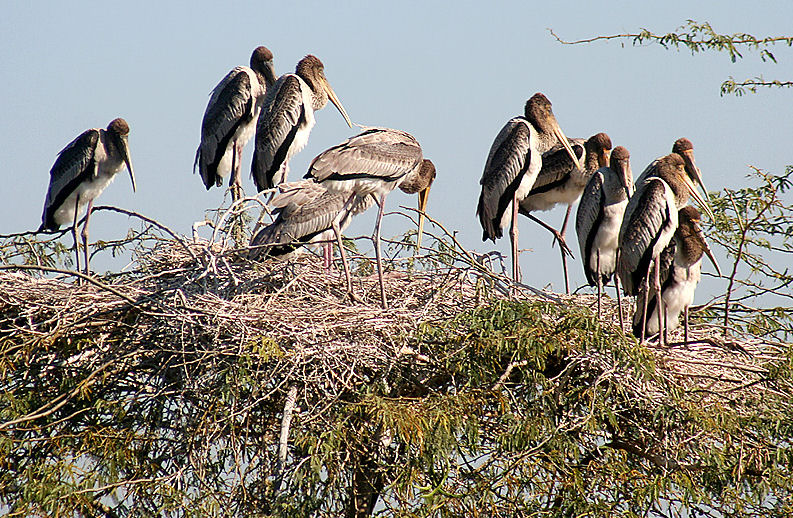
Abb.:
कुलायाः । Nest von Mycteria leucocephala Pennant, 1769 - Painted Stork -
Buntstorch, Bharatpur - भरतपुर, Rajasthan
[Bildquelle: J. M. Garg / Wikimedia. -- GNU FDLicense]
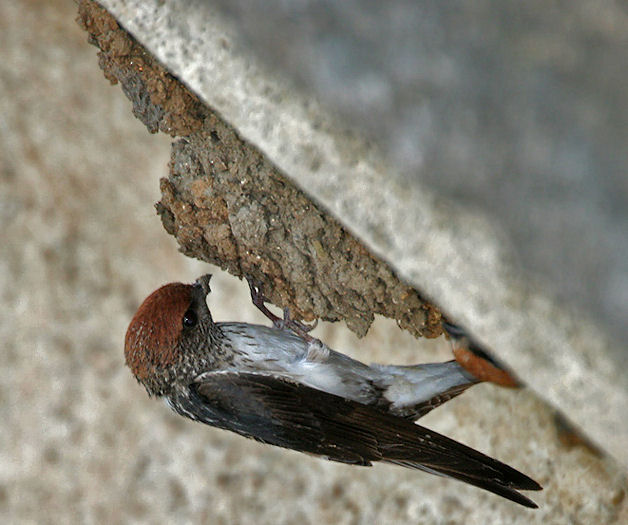
Abb.: नीडम् । Nest von Hirundo fluvicola Blyth, 1855 - Streaked-throated Swallow,
Kawal Wildlife Sanctuary, Andhra Pradesh
[Bildquelle: J. M. Garg / Wikimedia. -- GNU FDLicense]
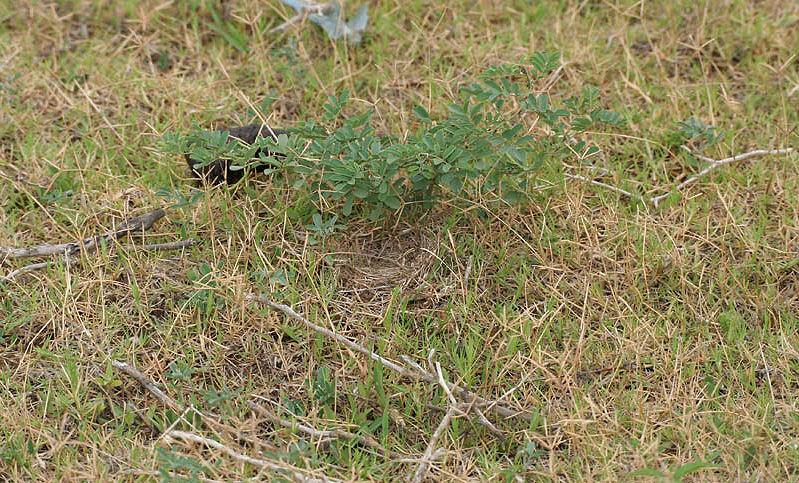
Abb.:
कुलायः । Nest von Eremopterix griseus Scopoli, 1786 - Ashy-crowned
Finch-lark, Hyderabad - హైదరాబాదు,
Andhra Pradesh
[Bildquelle: J. M. Garg / Wikimedia. -- GNU FDLicense]
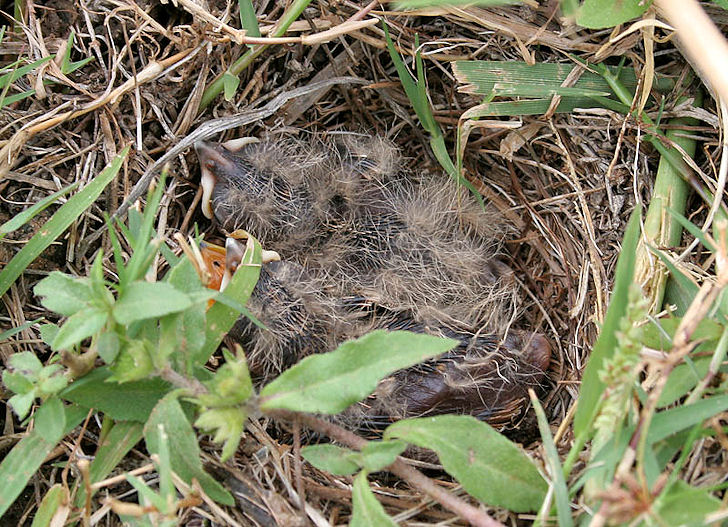
Abb.: नीडम् । Nest von Anthus rufulus (?) Vieillot, 1818 - Paddyfield Pipit,
Hyderabad - హైదరాబాదు, Andhra
Pradesh
[Bildquelle: J. M. Garg / Wikimedia. -- GNU FDLicense]
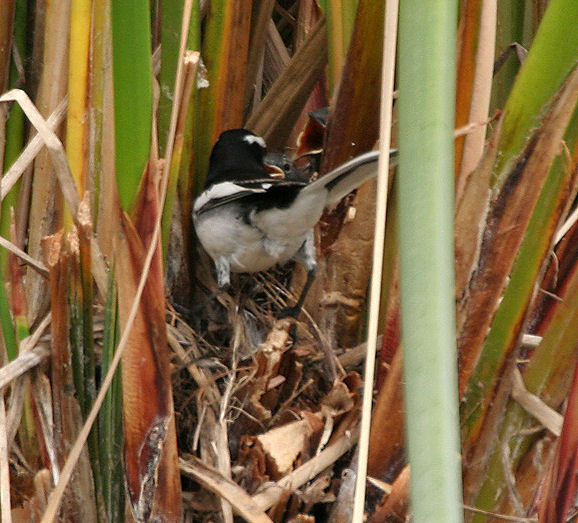
Abb.:
कुलायः । Nest von Motacilla maderaspatensis Gmelin, 1789 - White-browed
Wagtail - Mamulastelze, Hyderabad -
హైదరాబాదు, Andhra Pradesh
[Bildquelle: J. M. Garg / Wikimedia. -- GNU FDLicense]


















































































